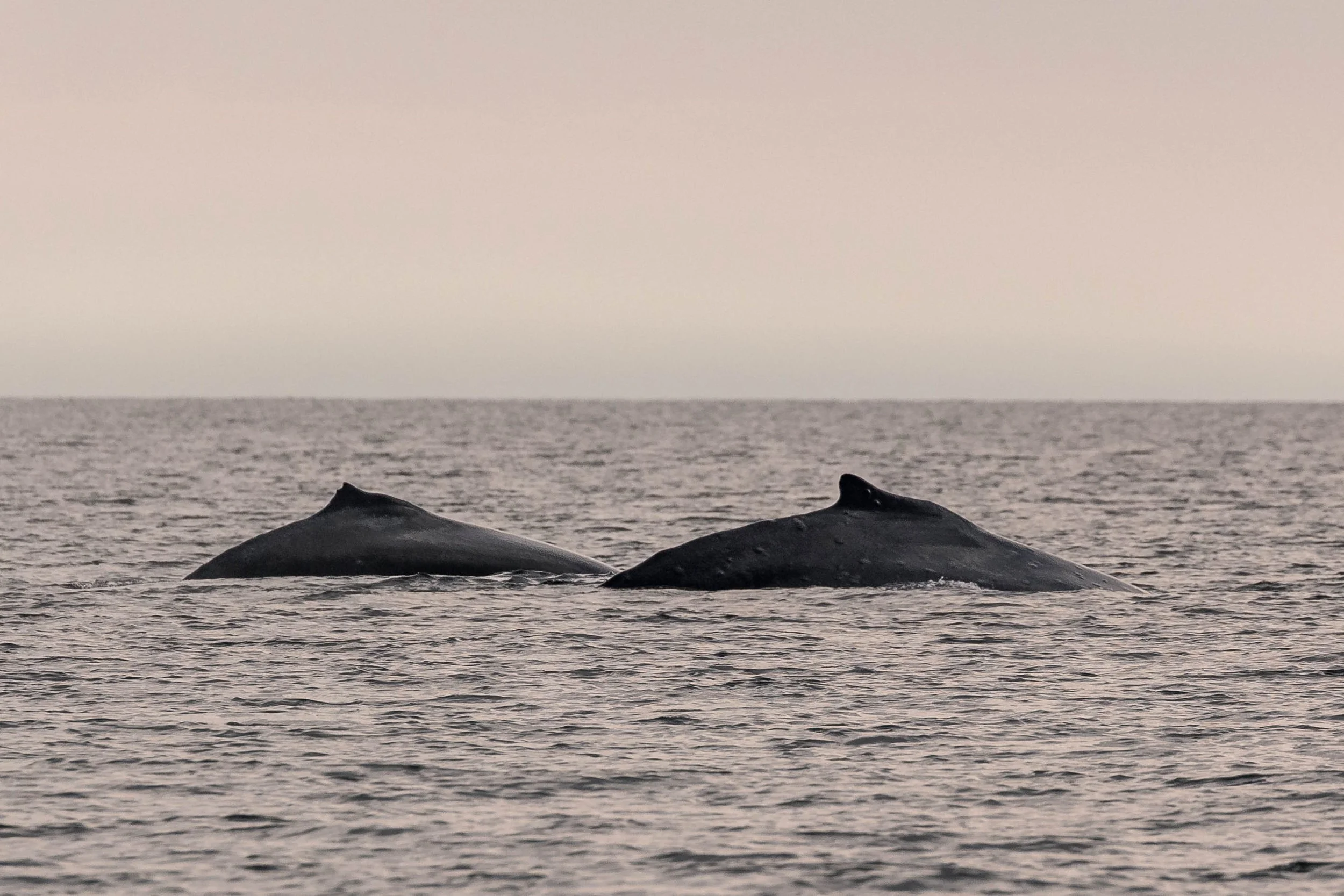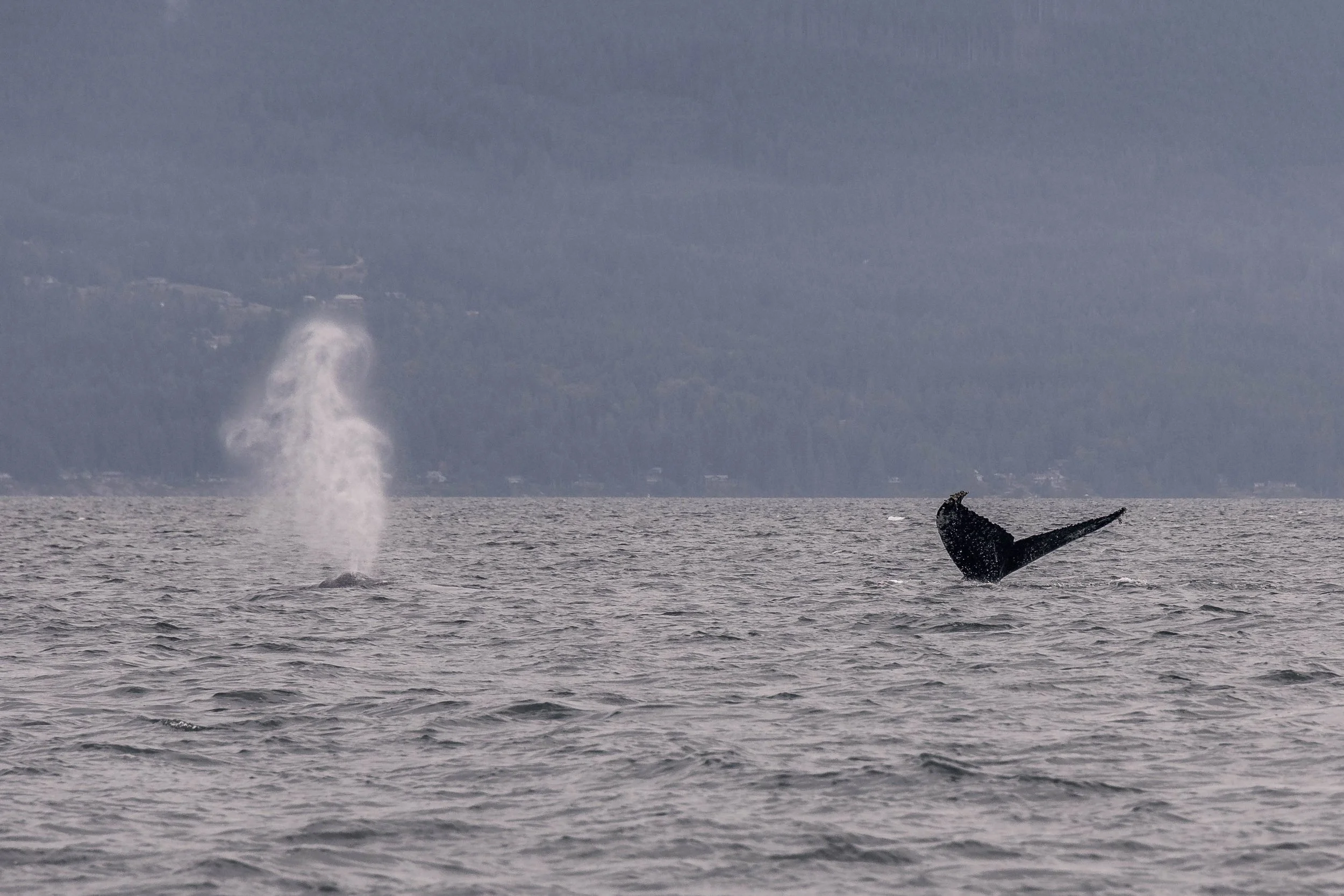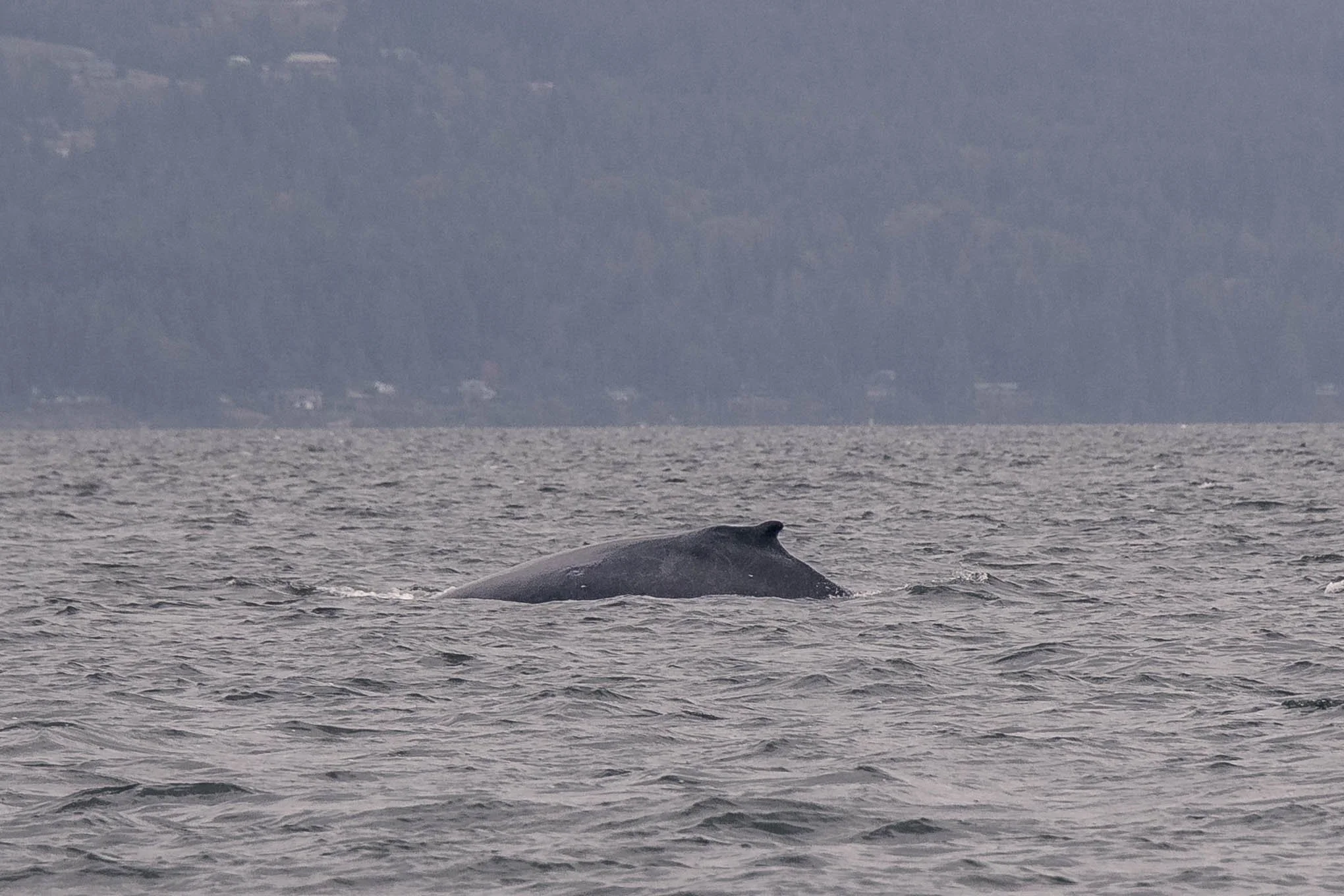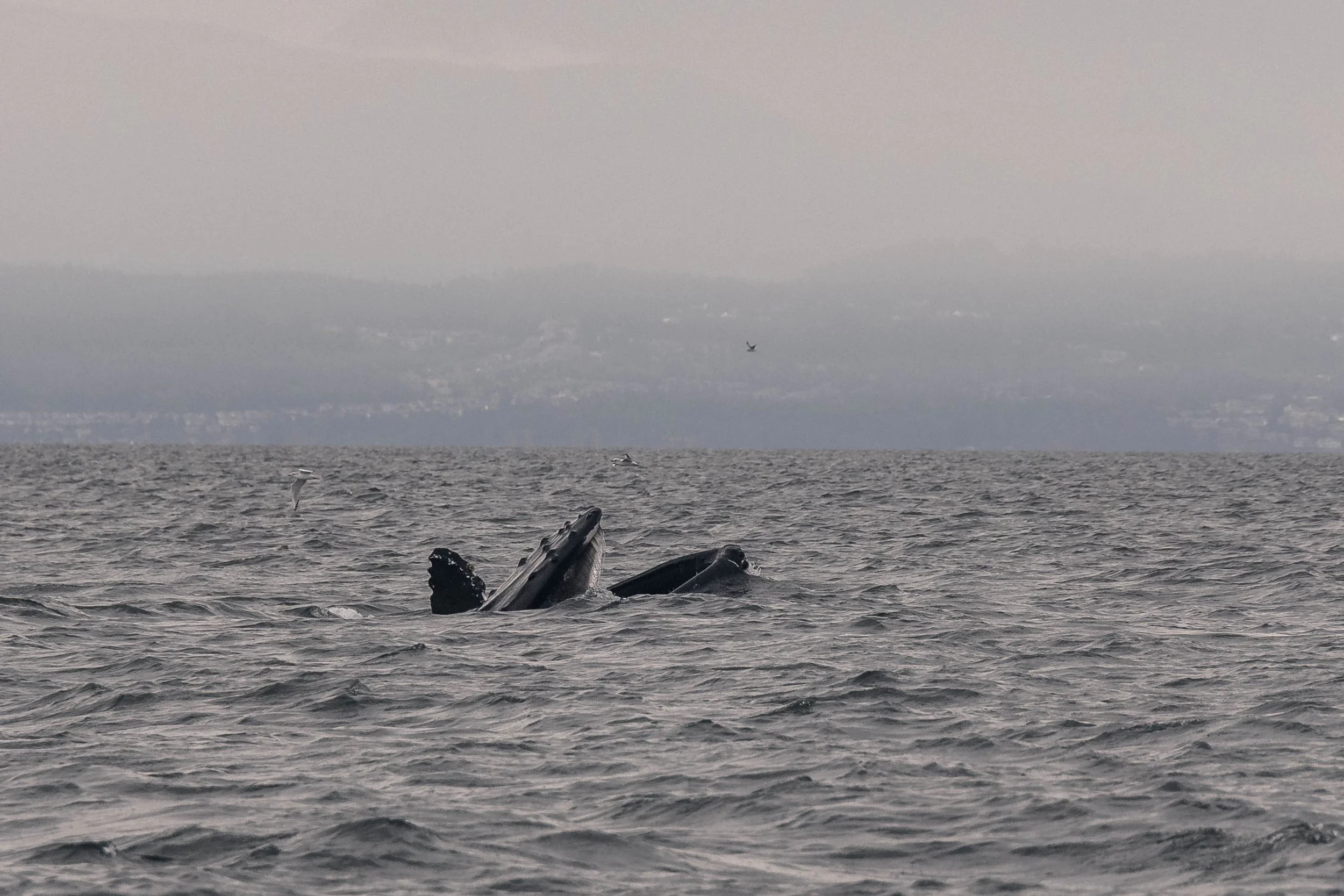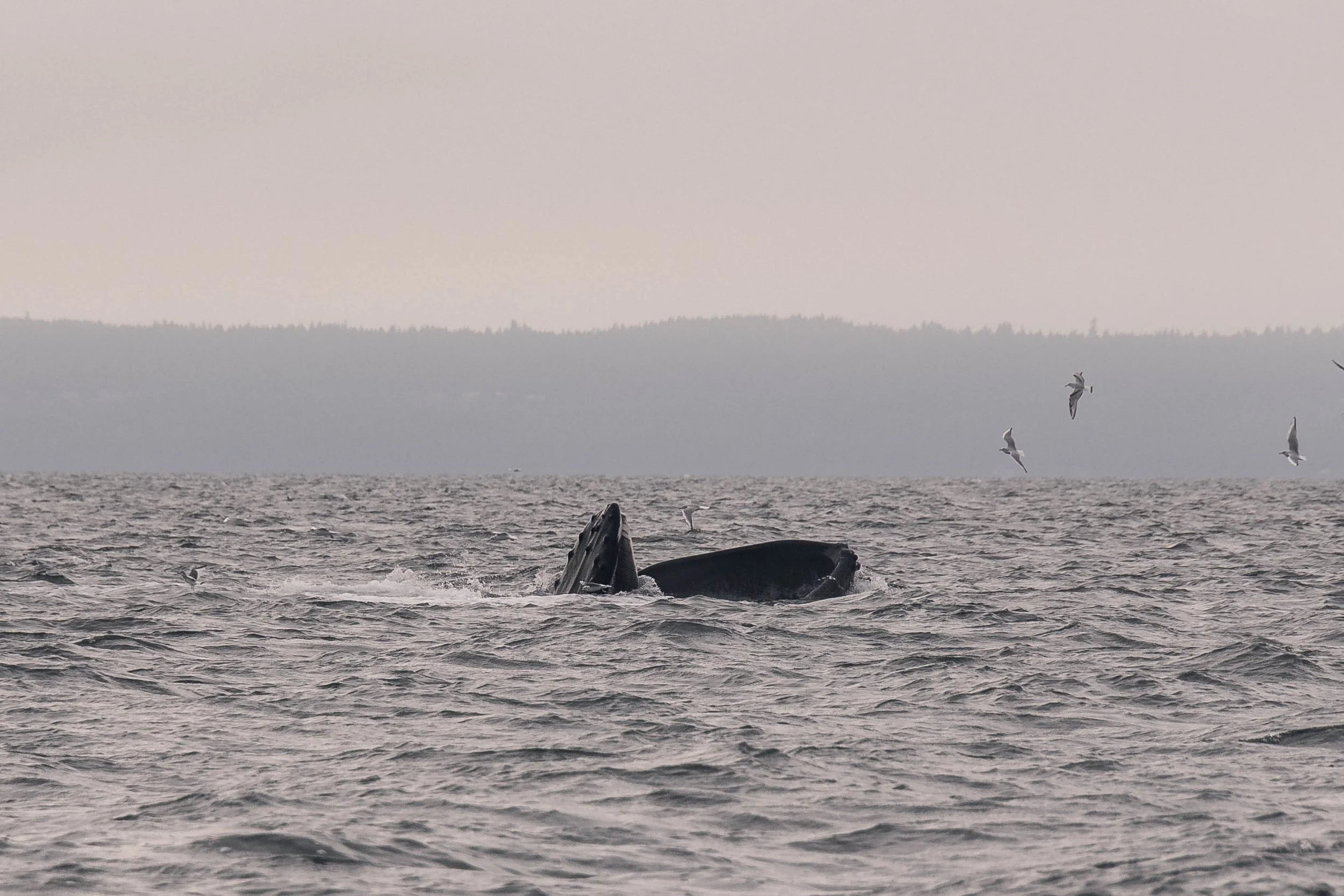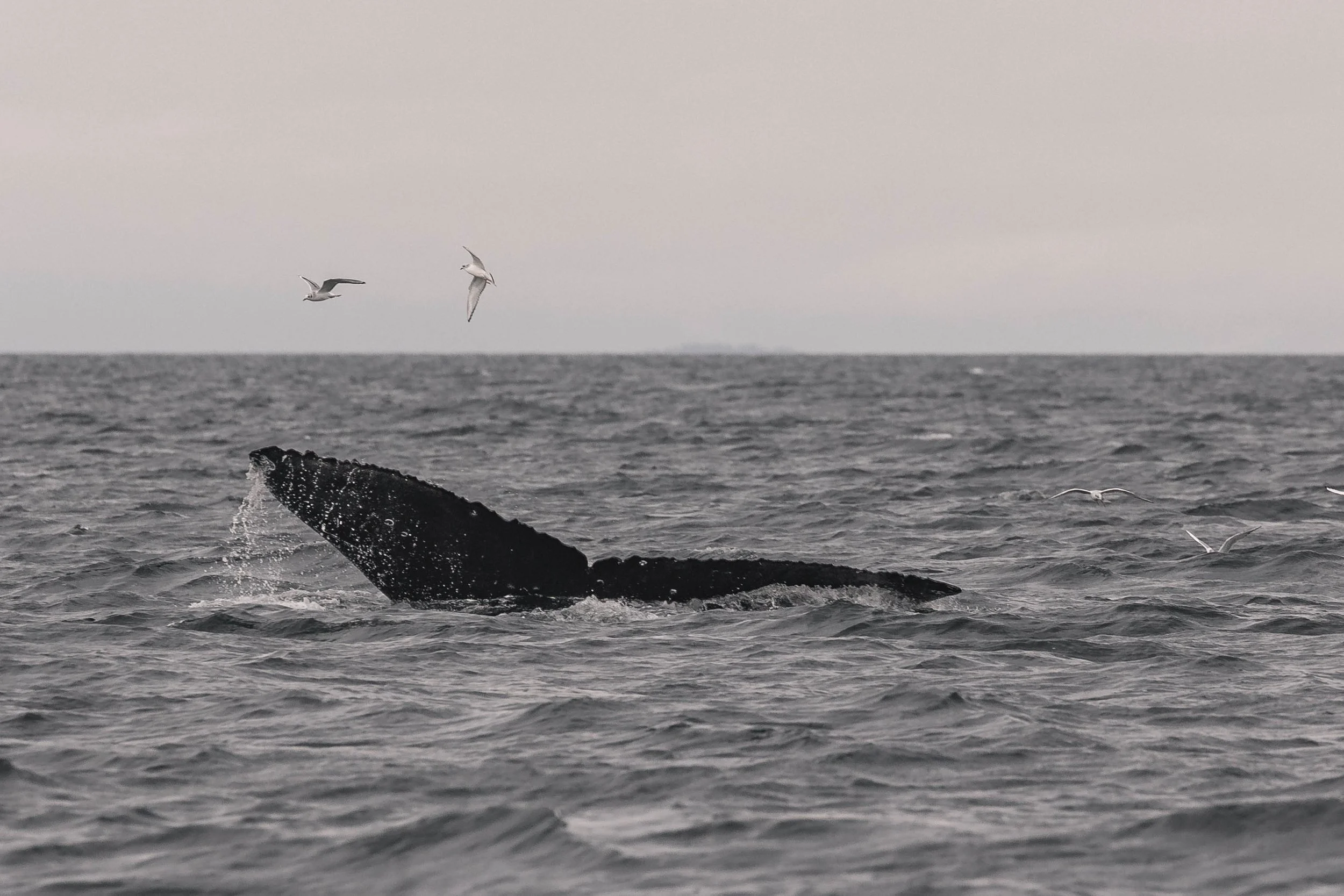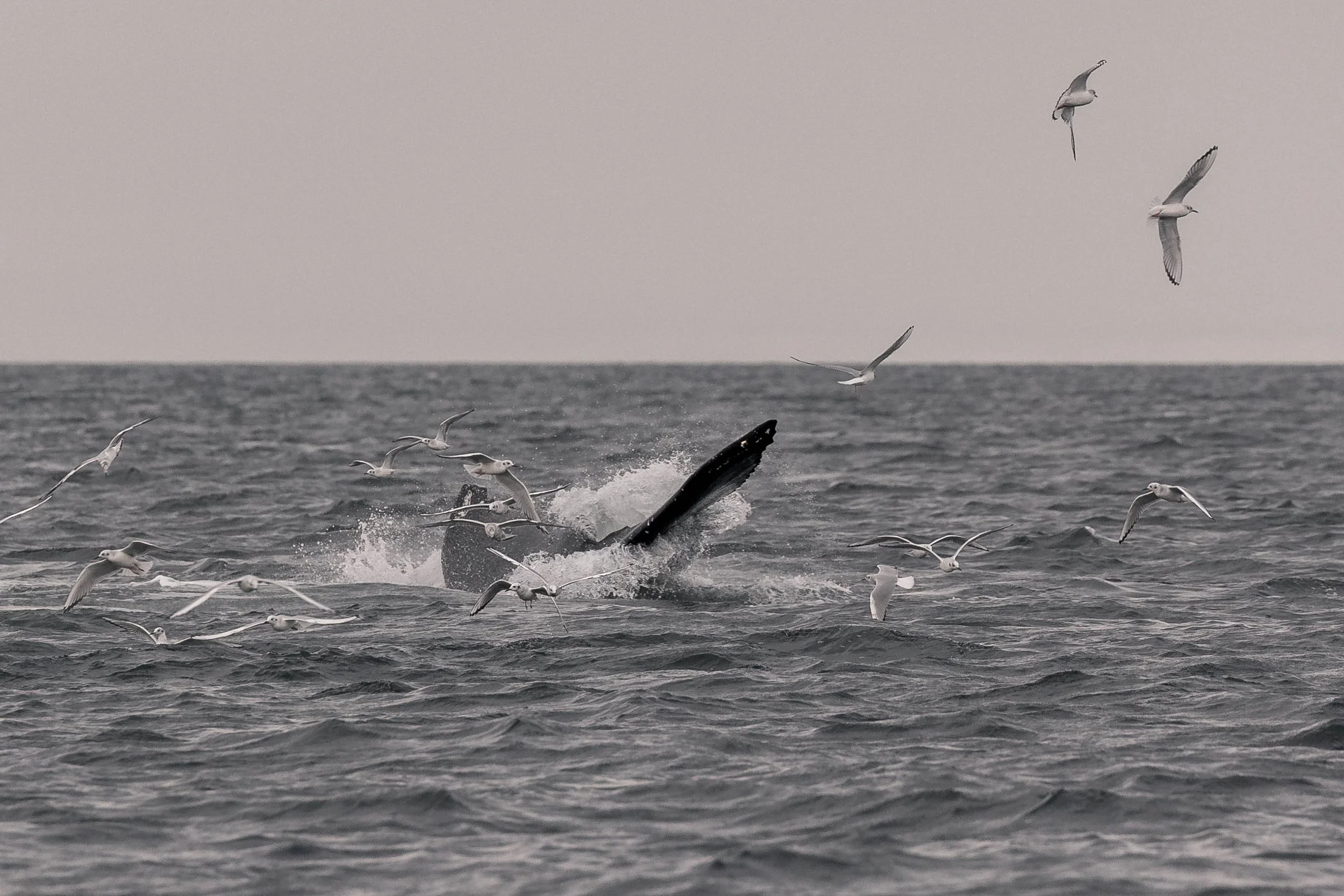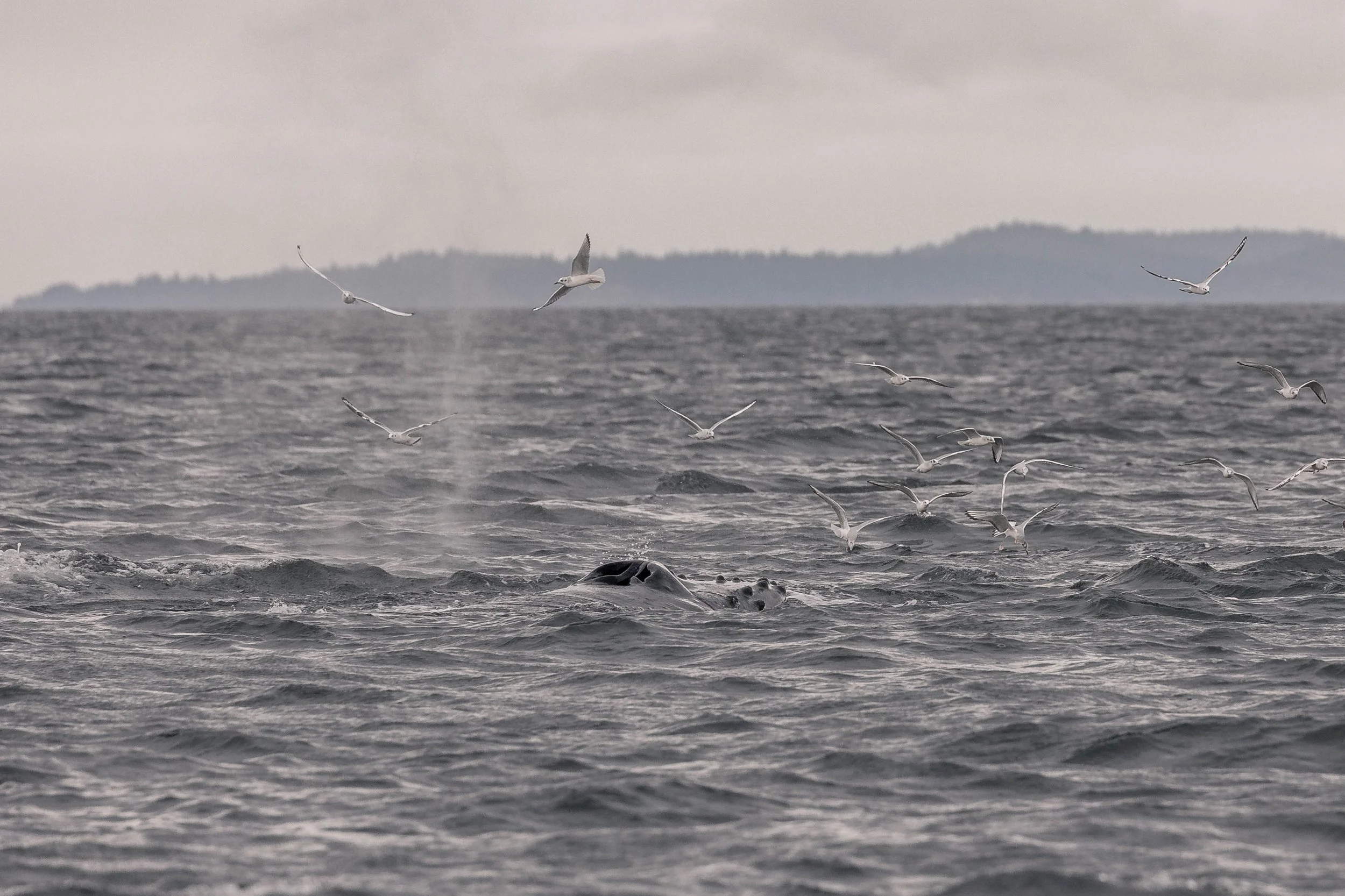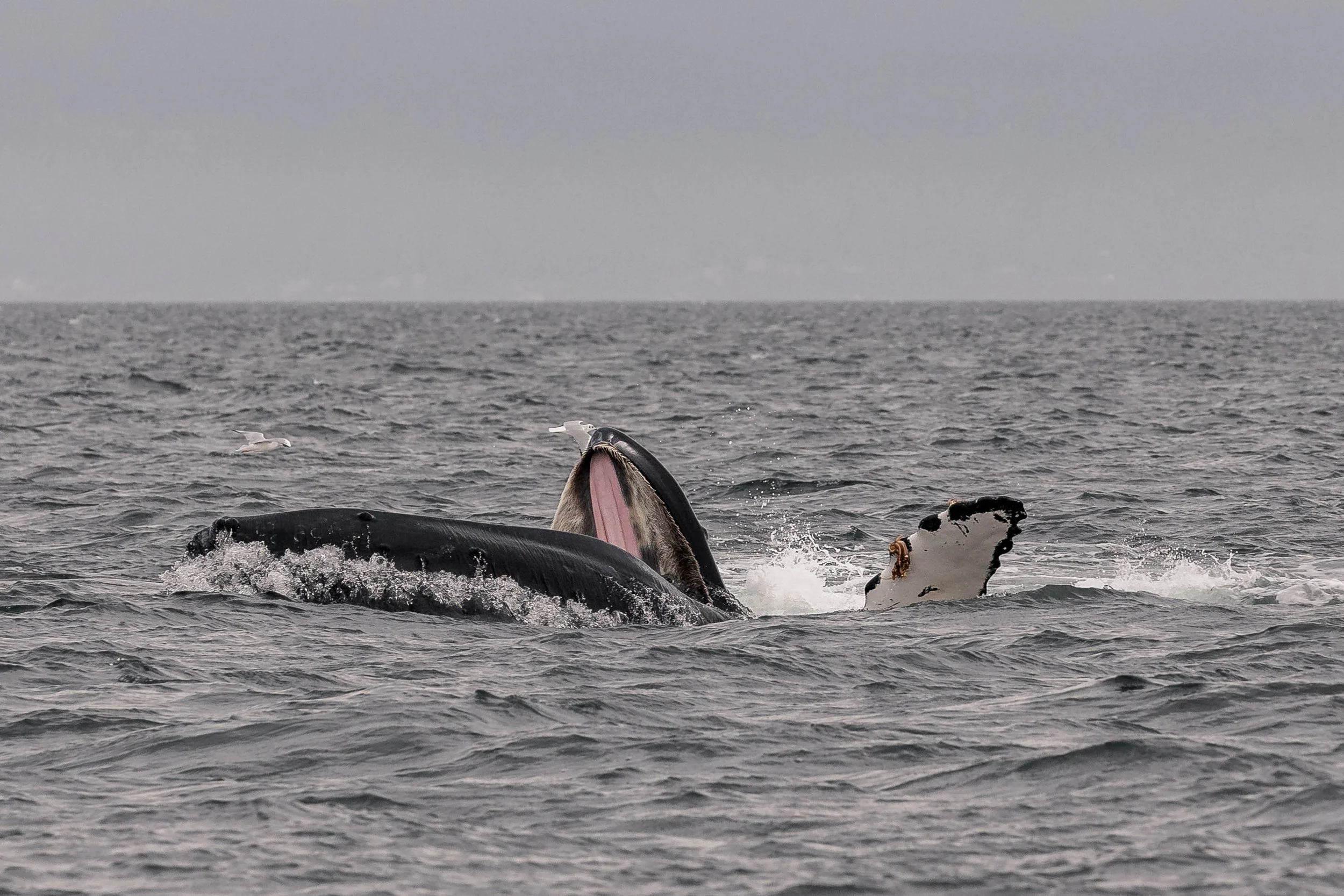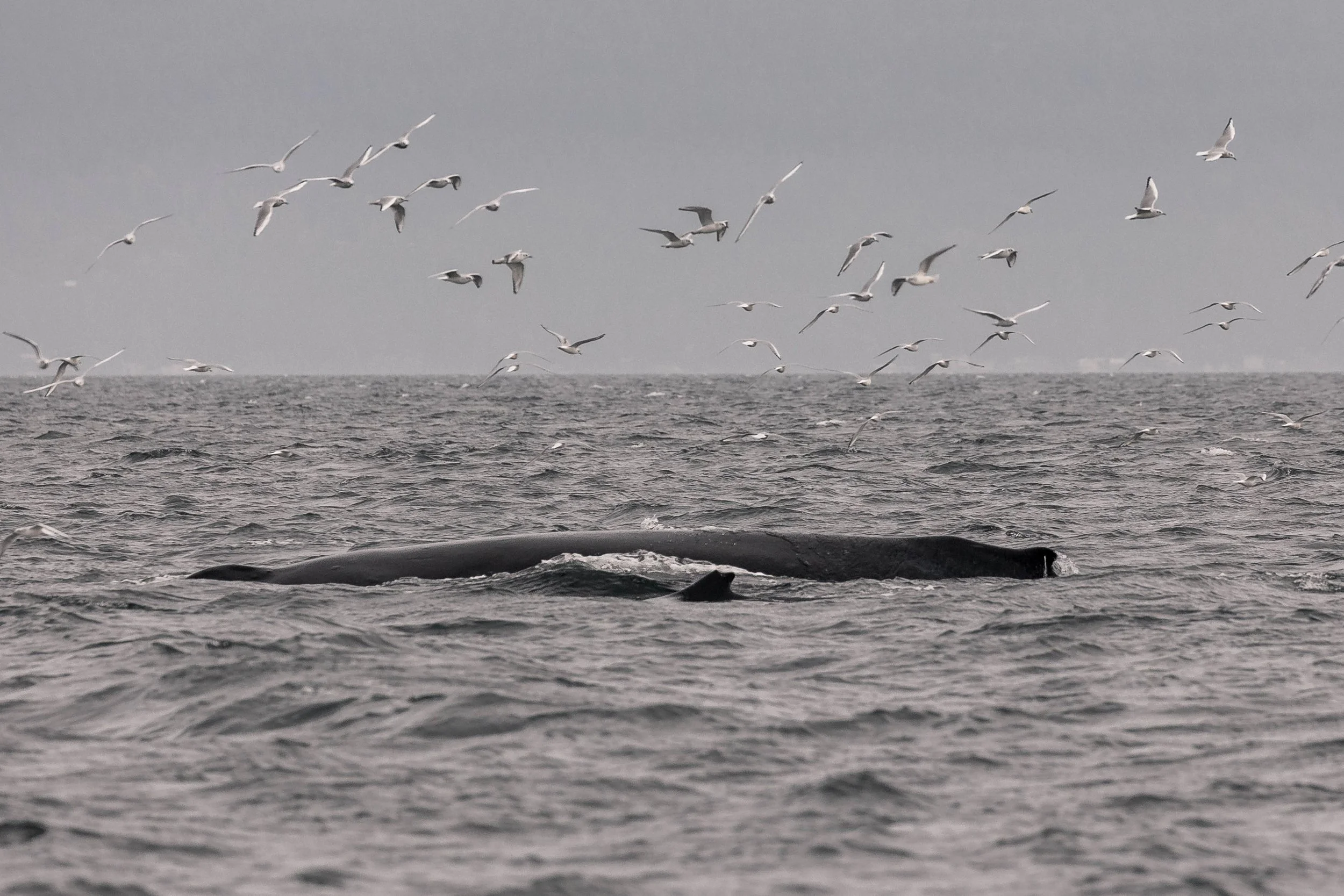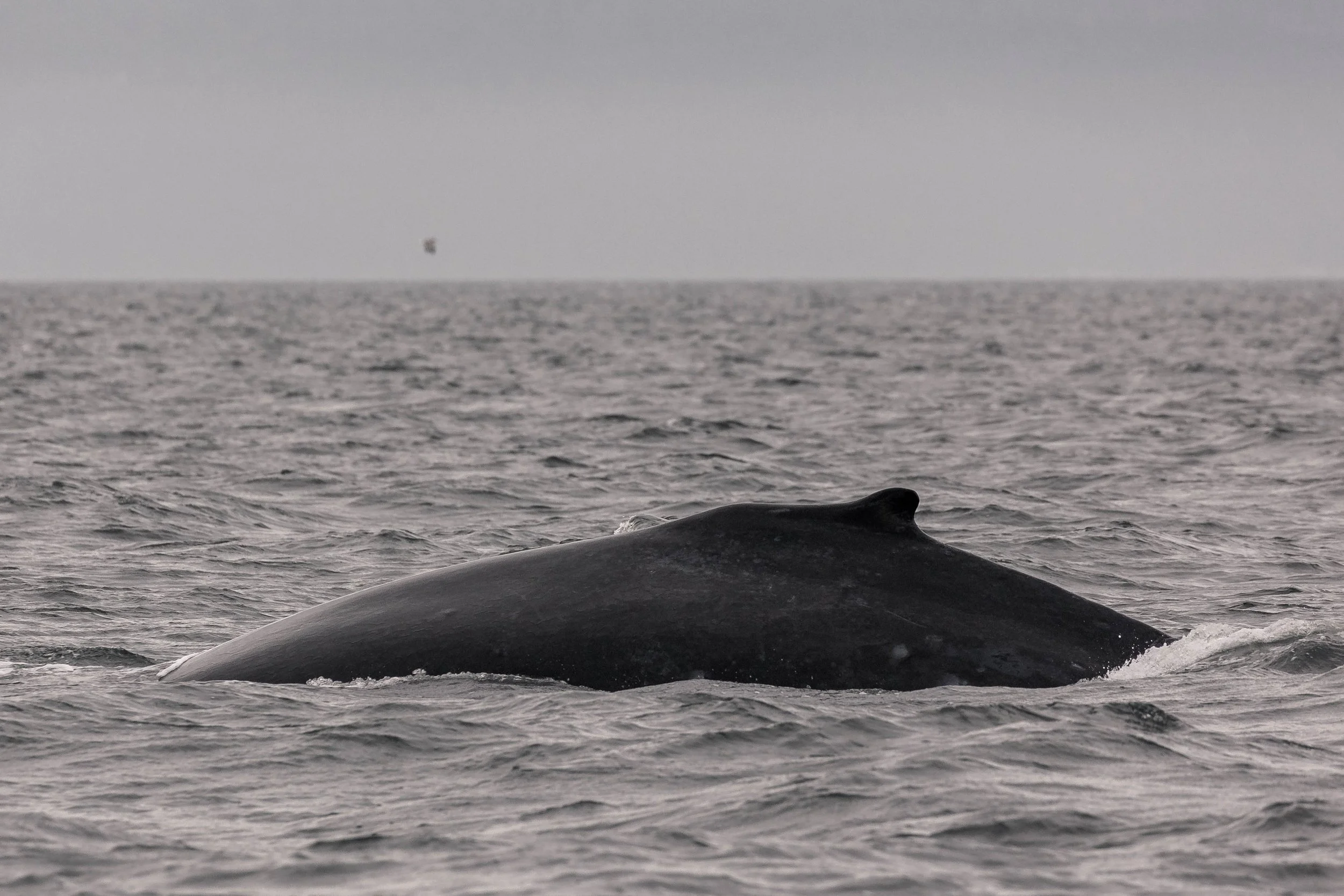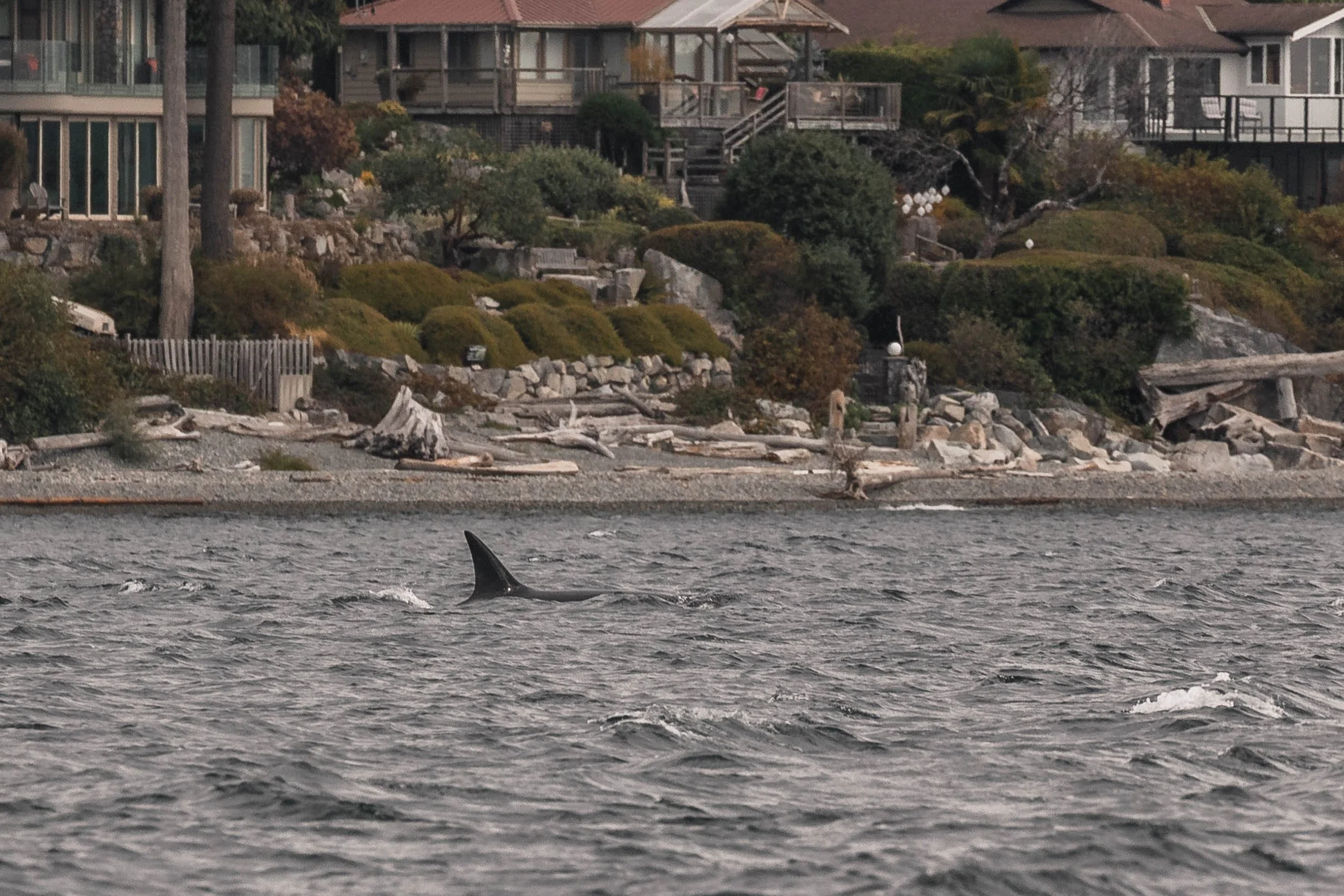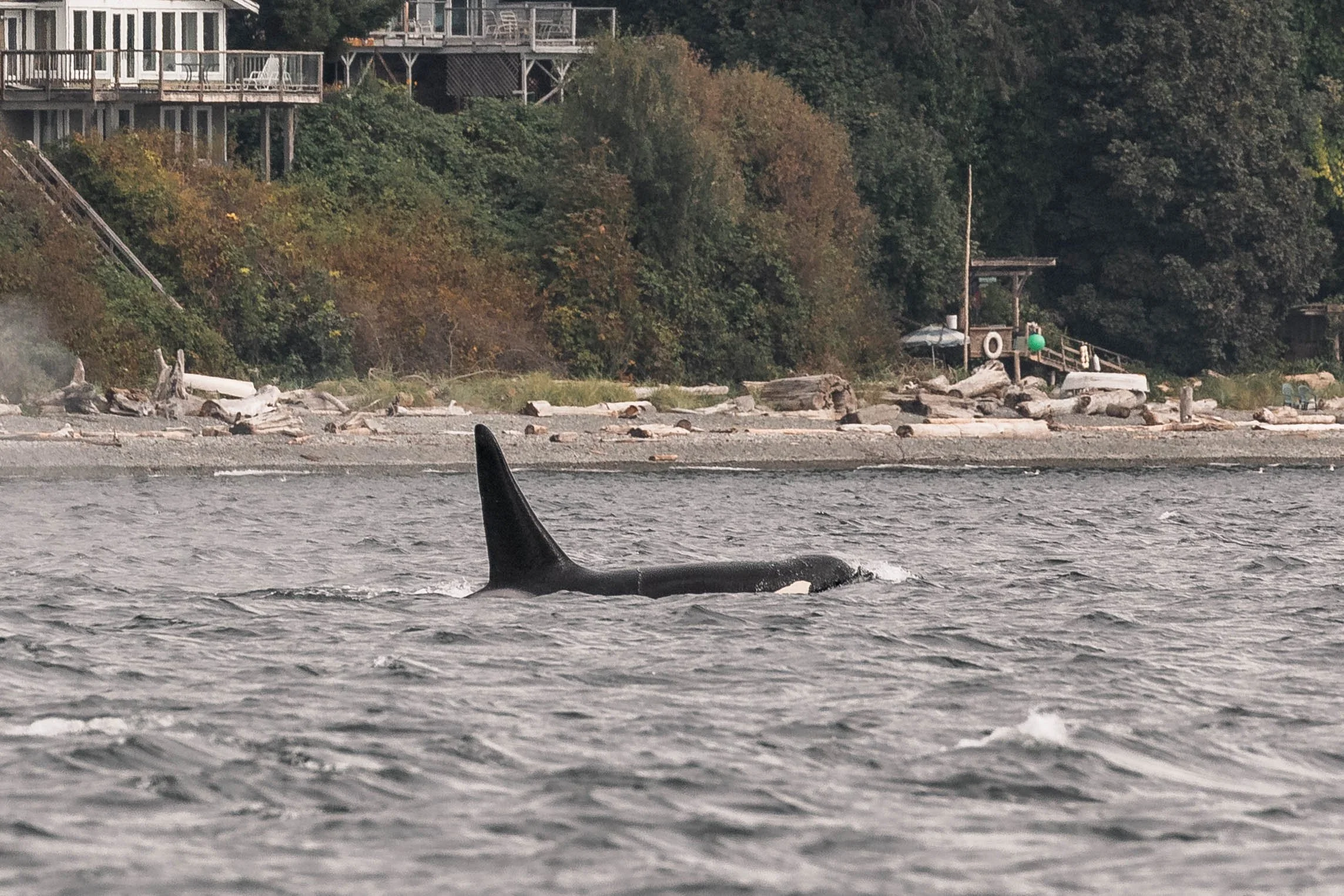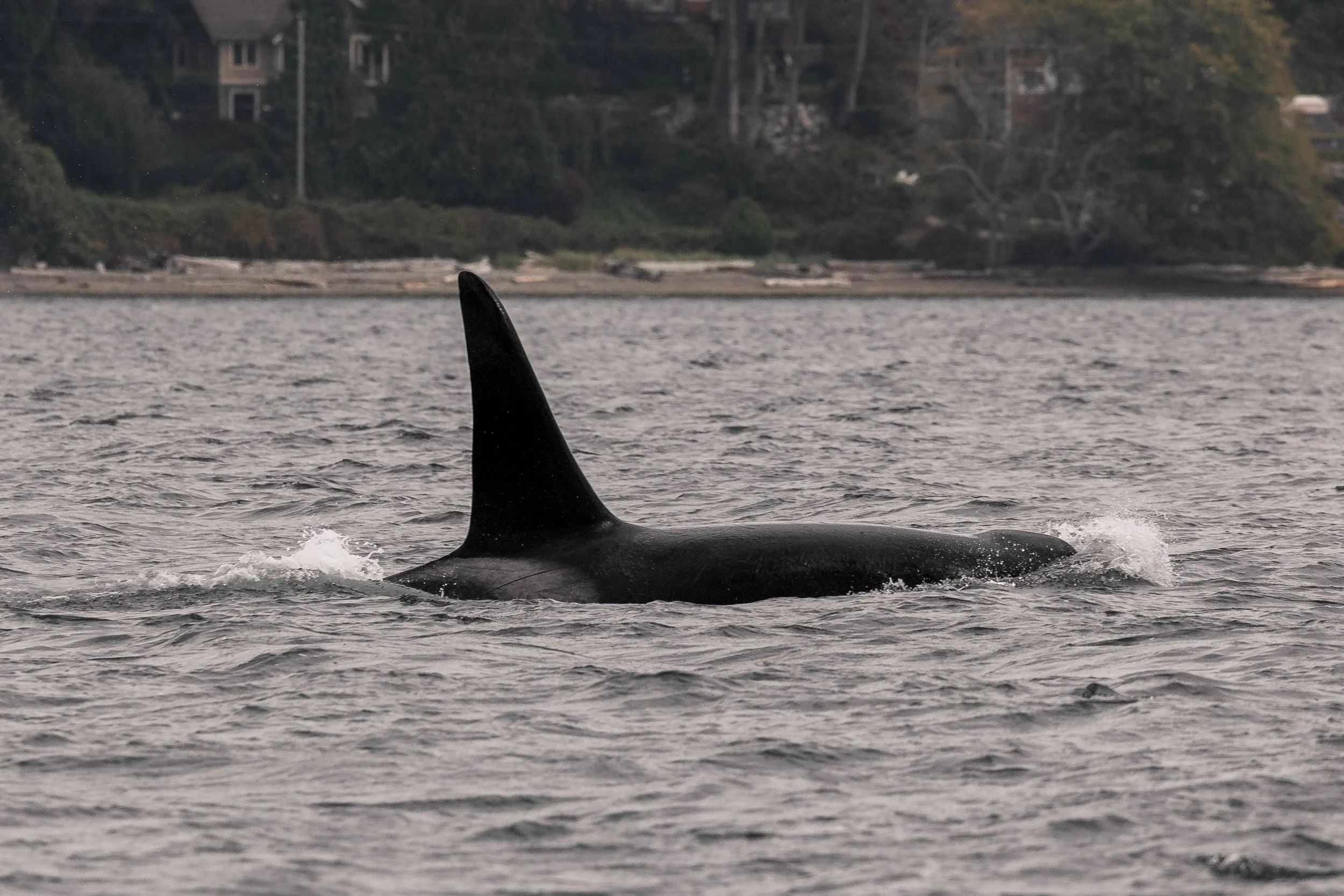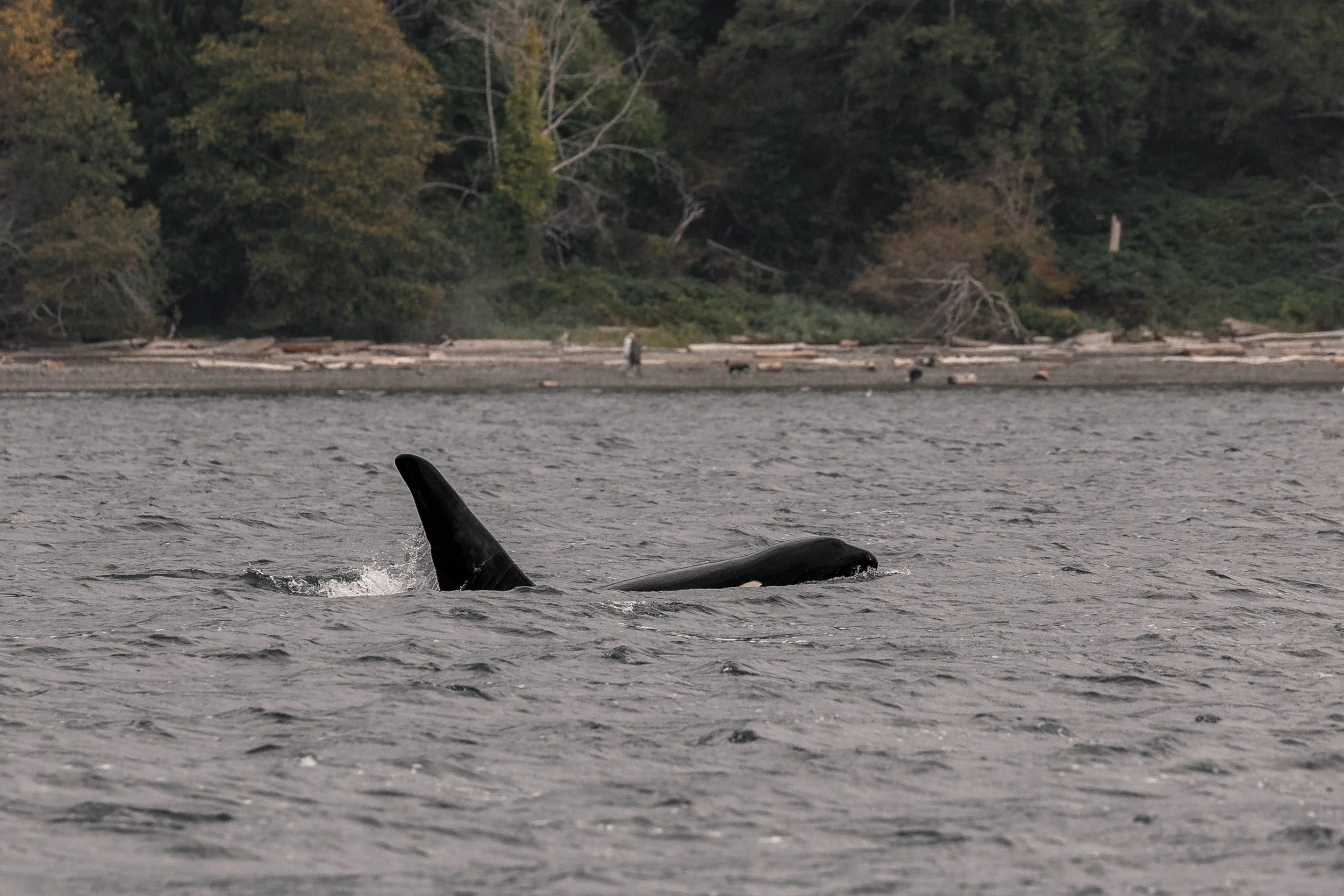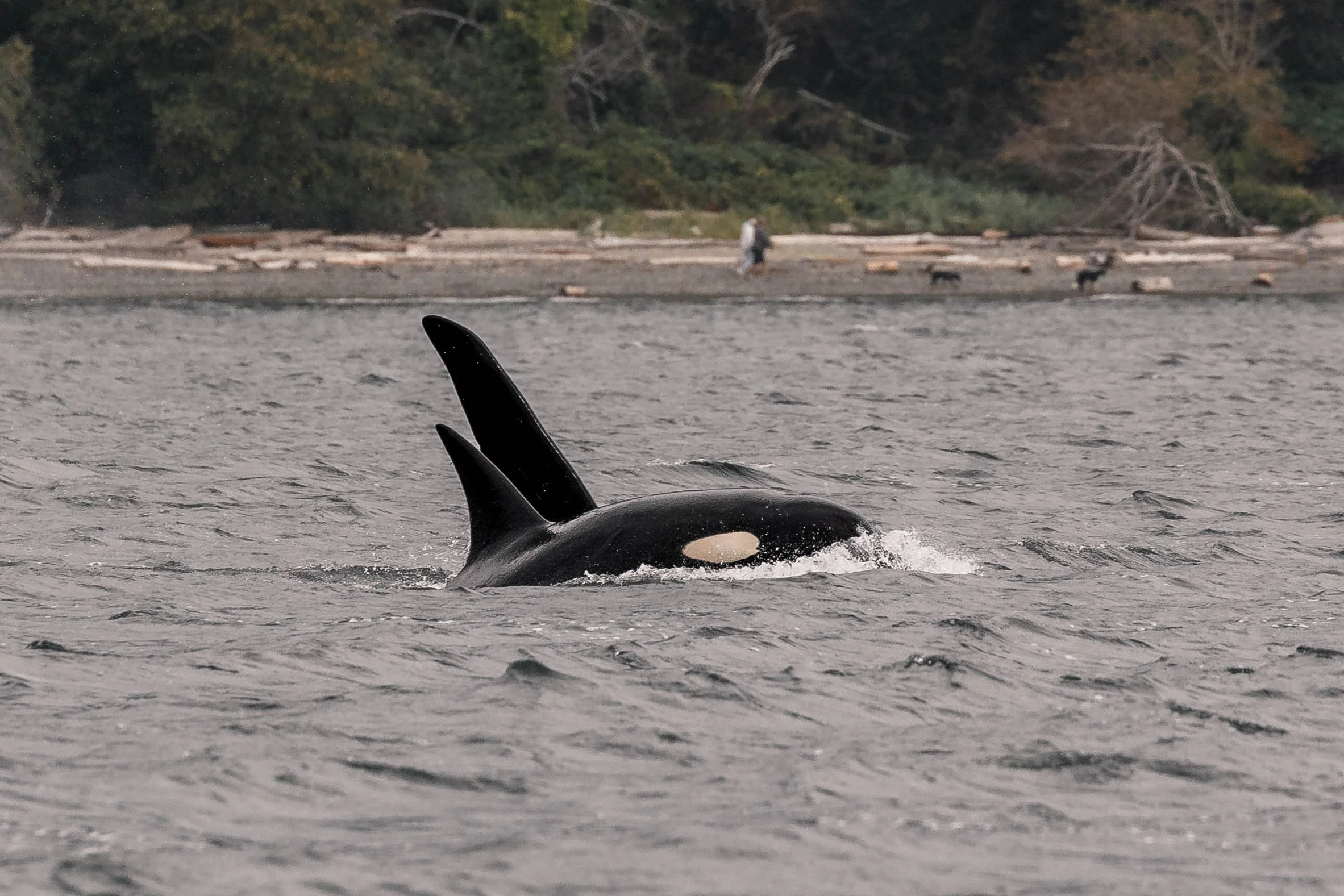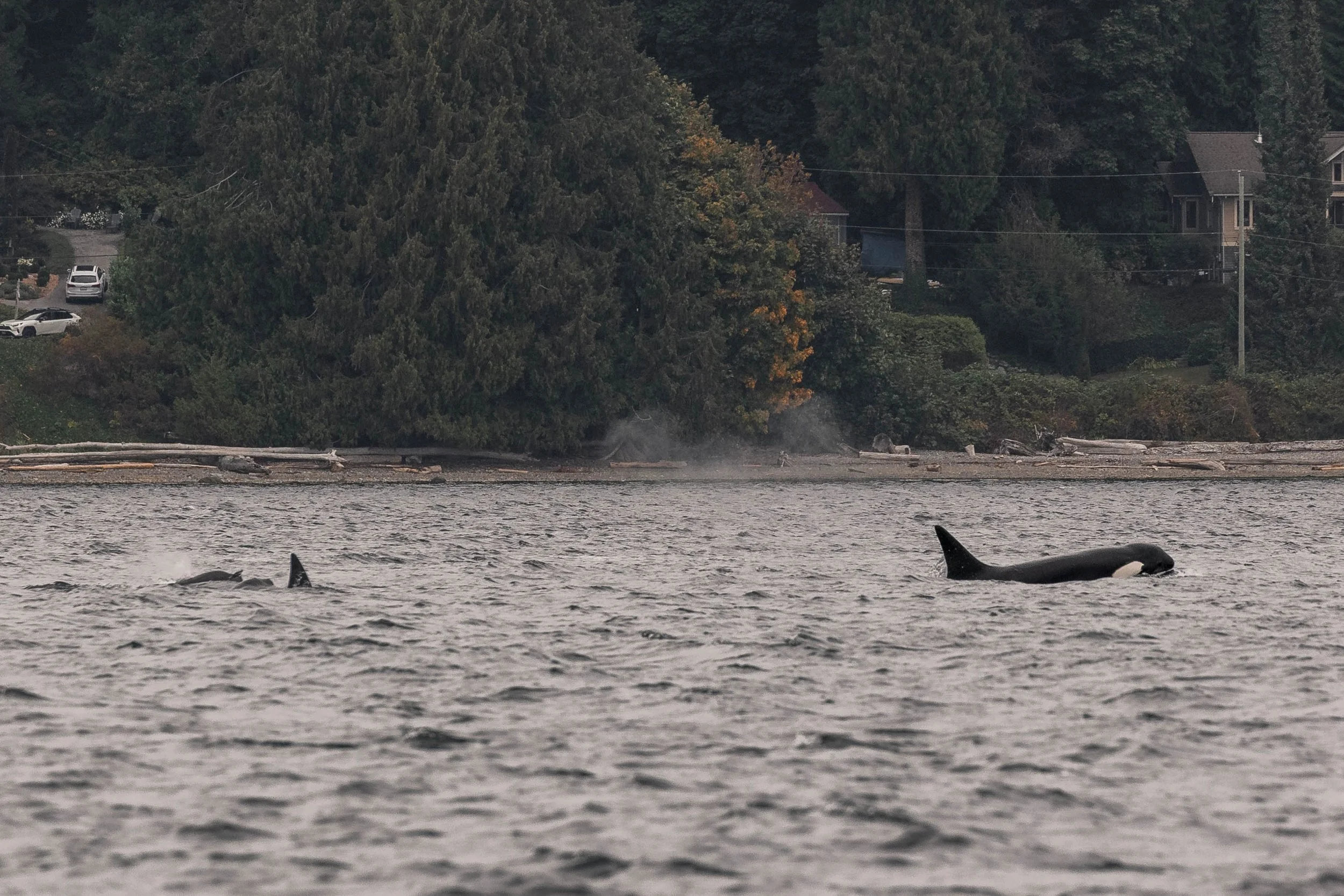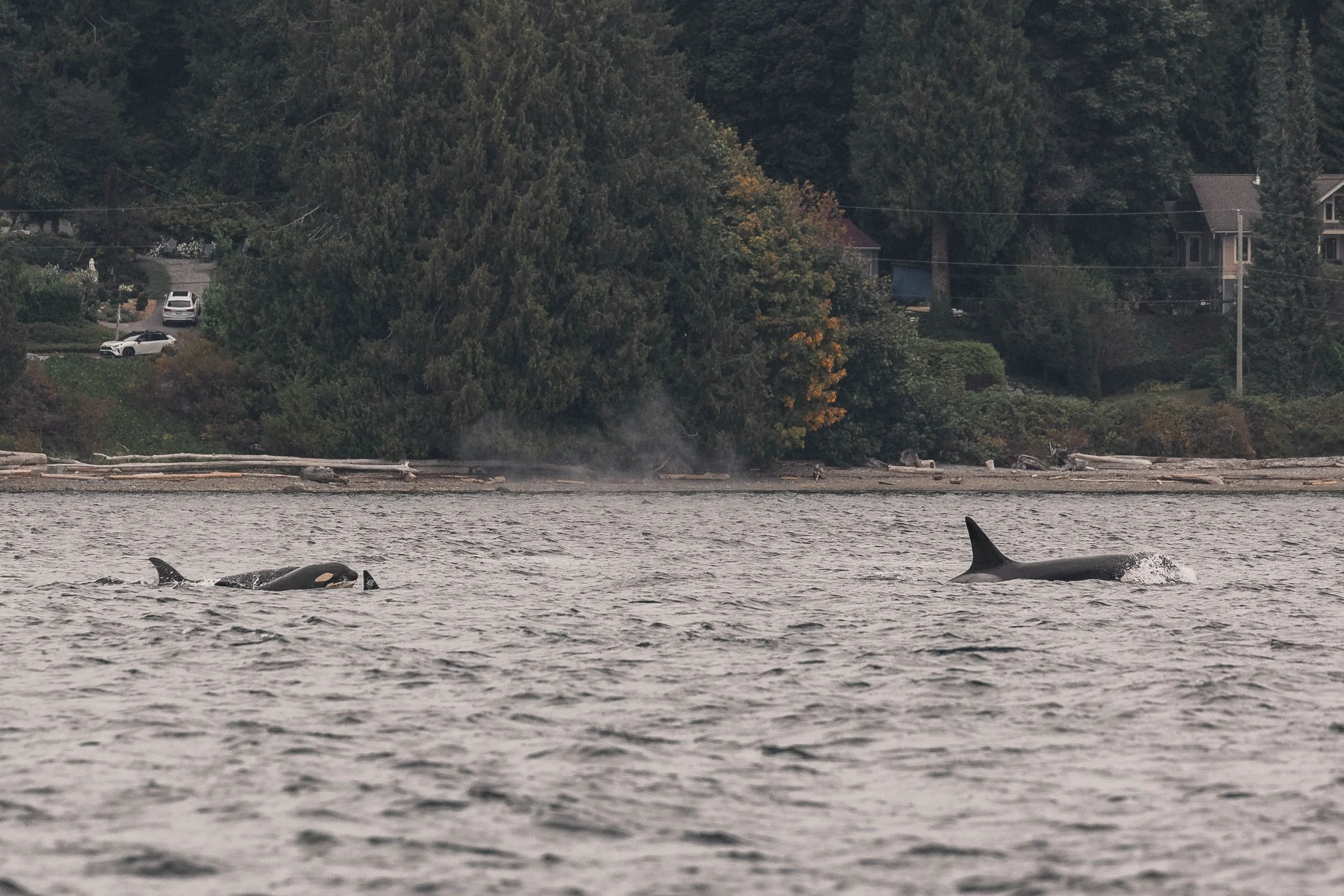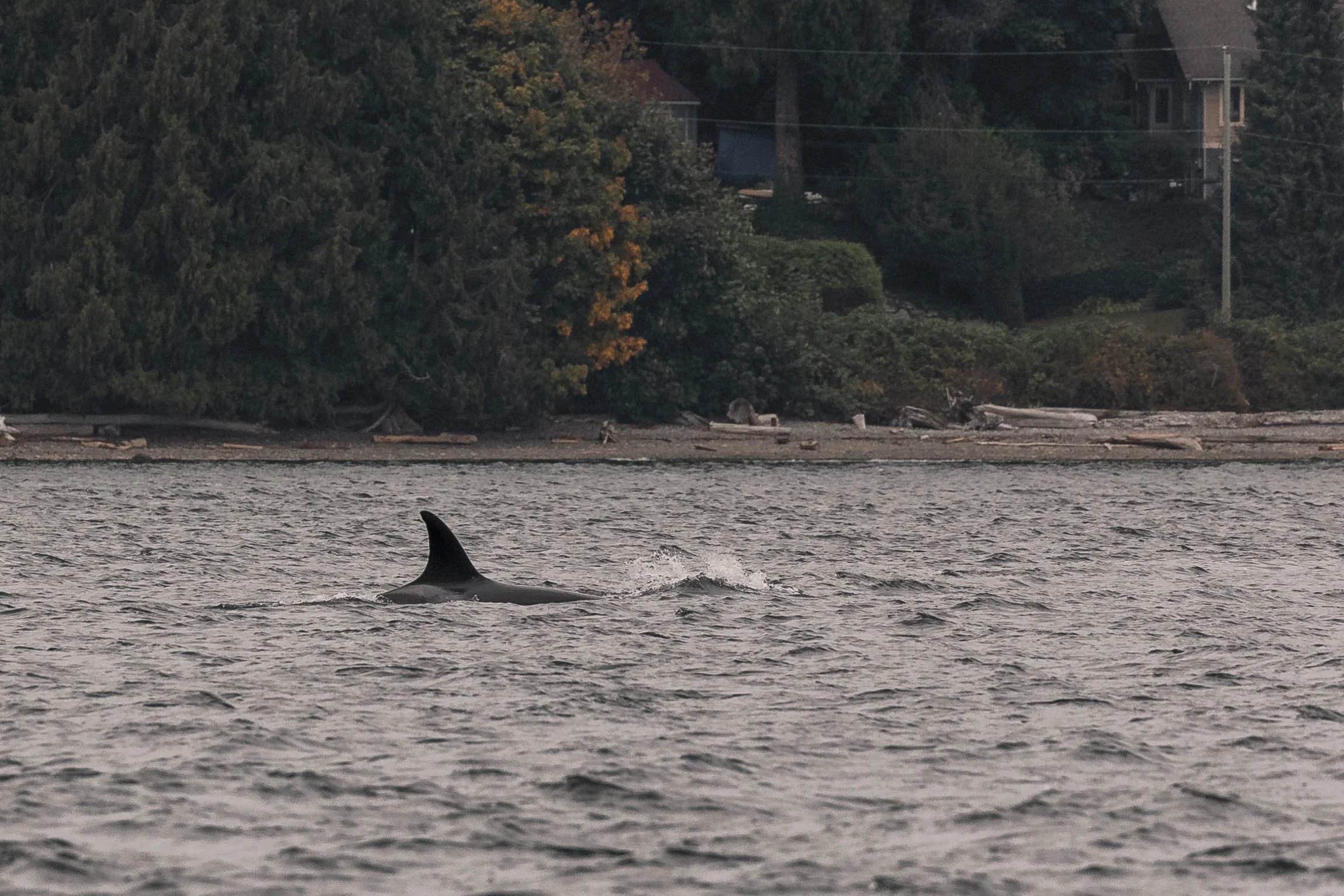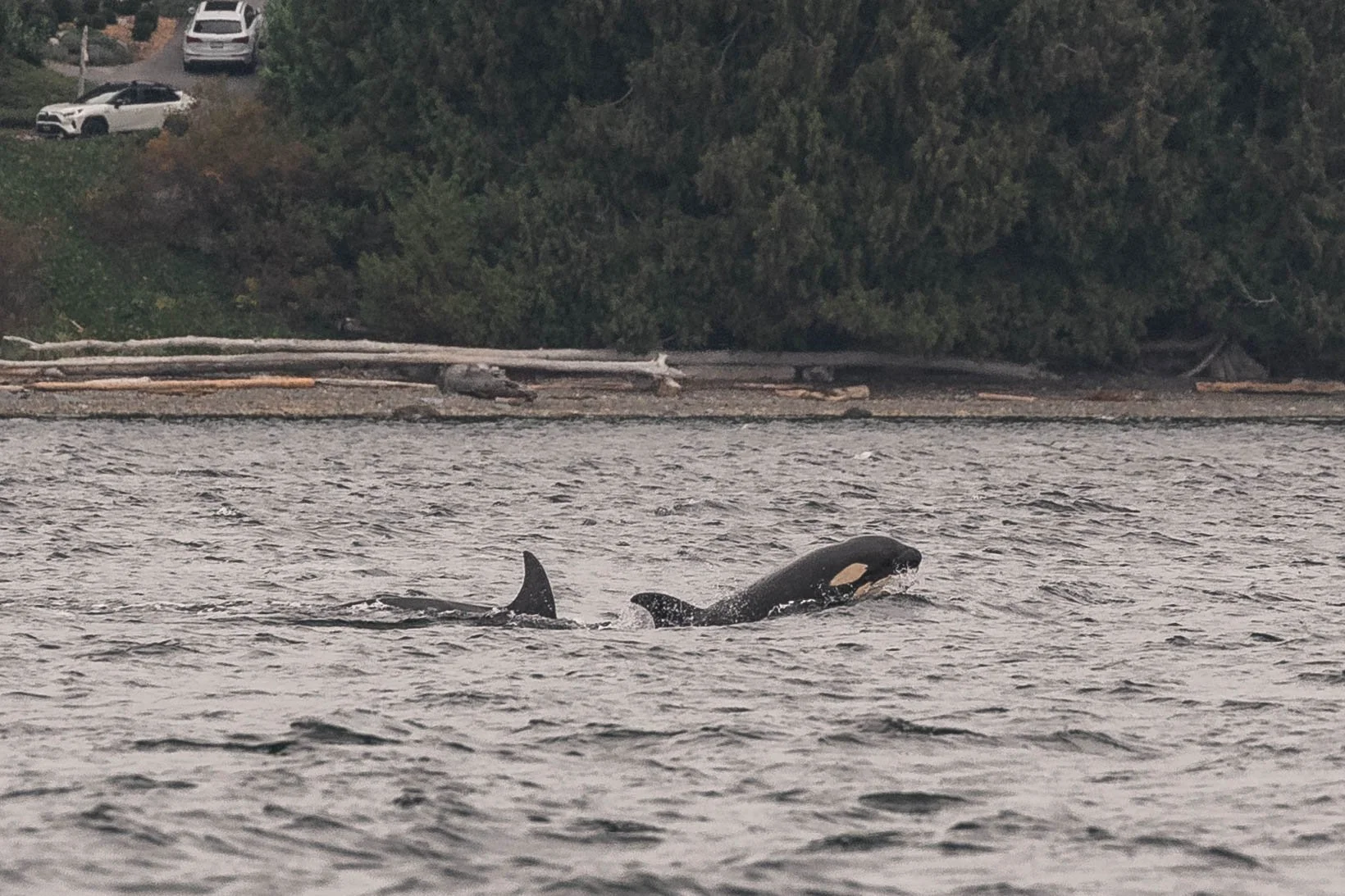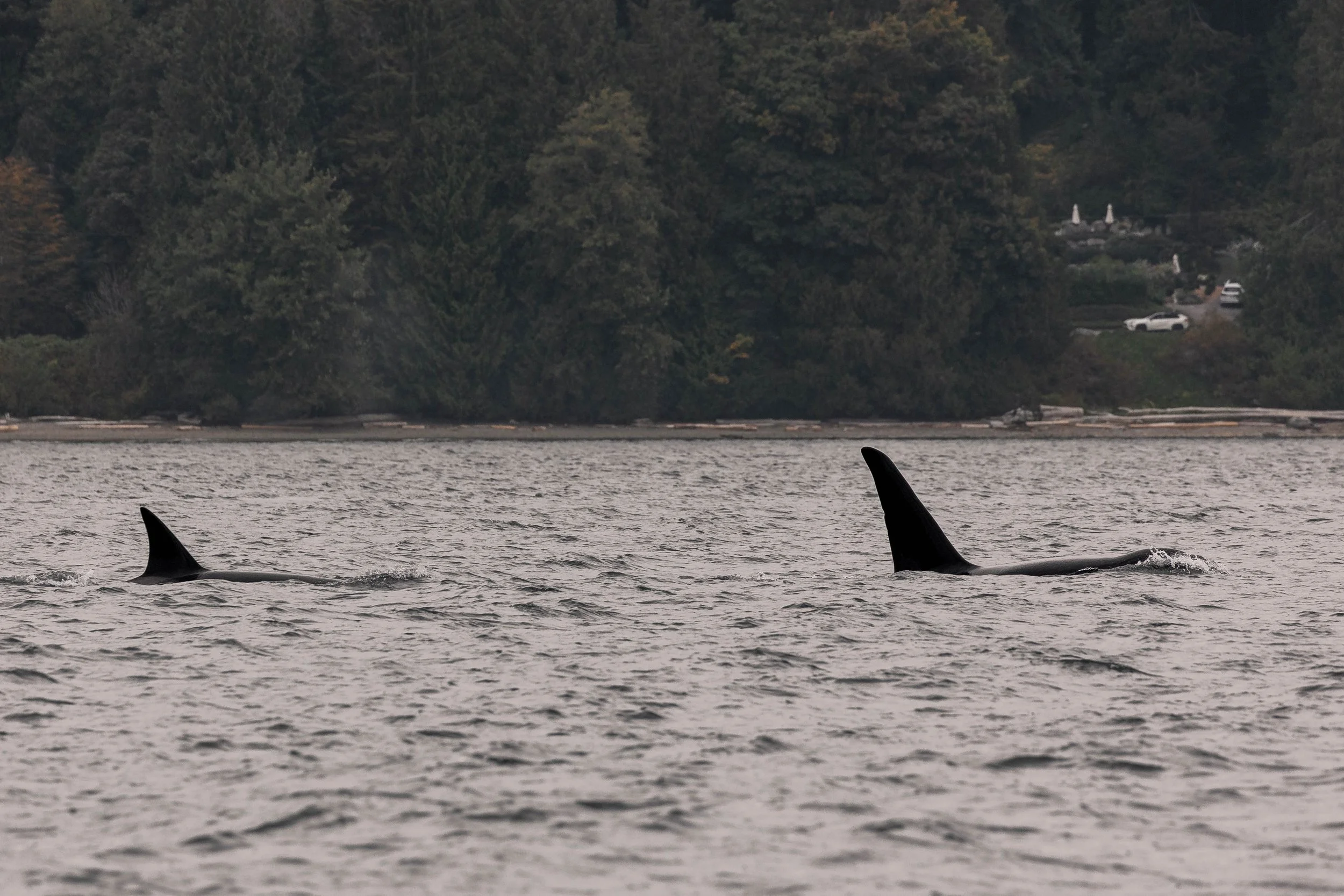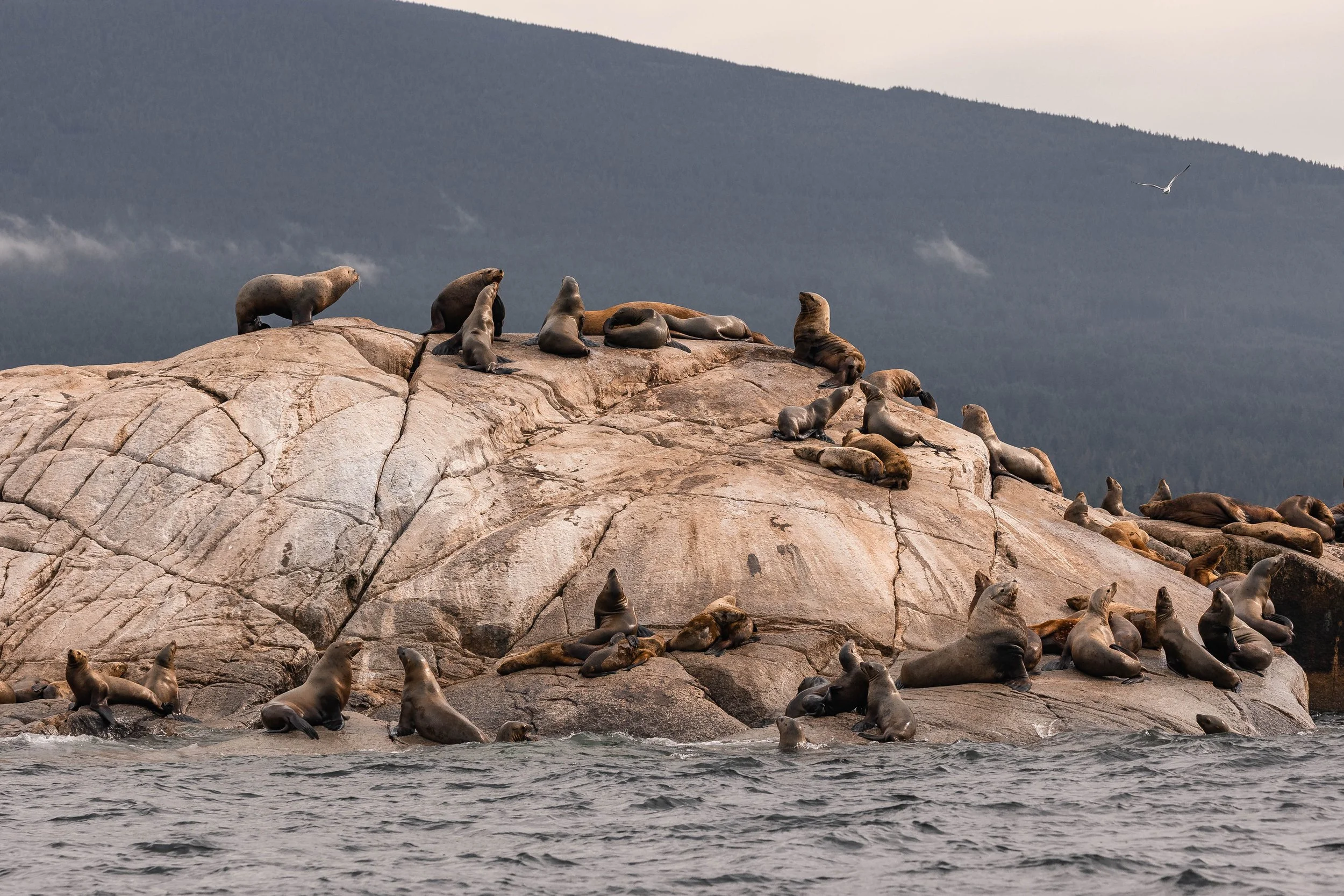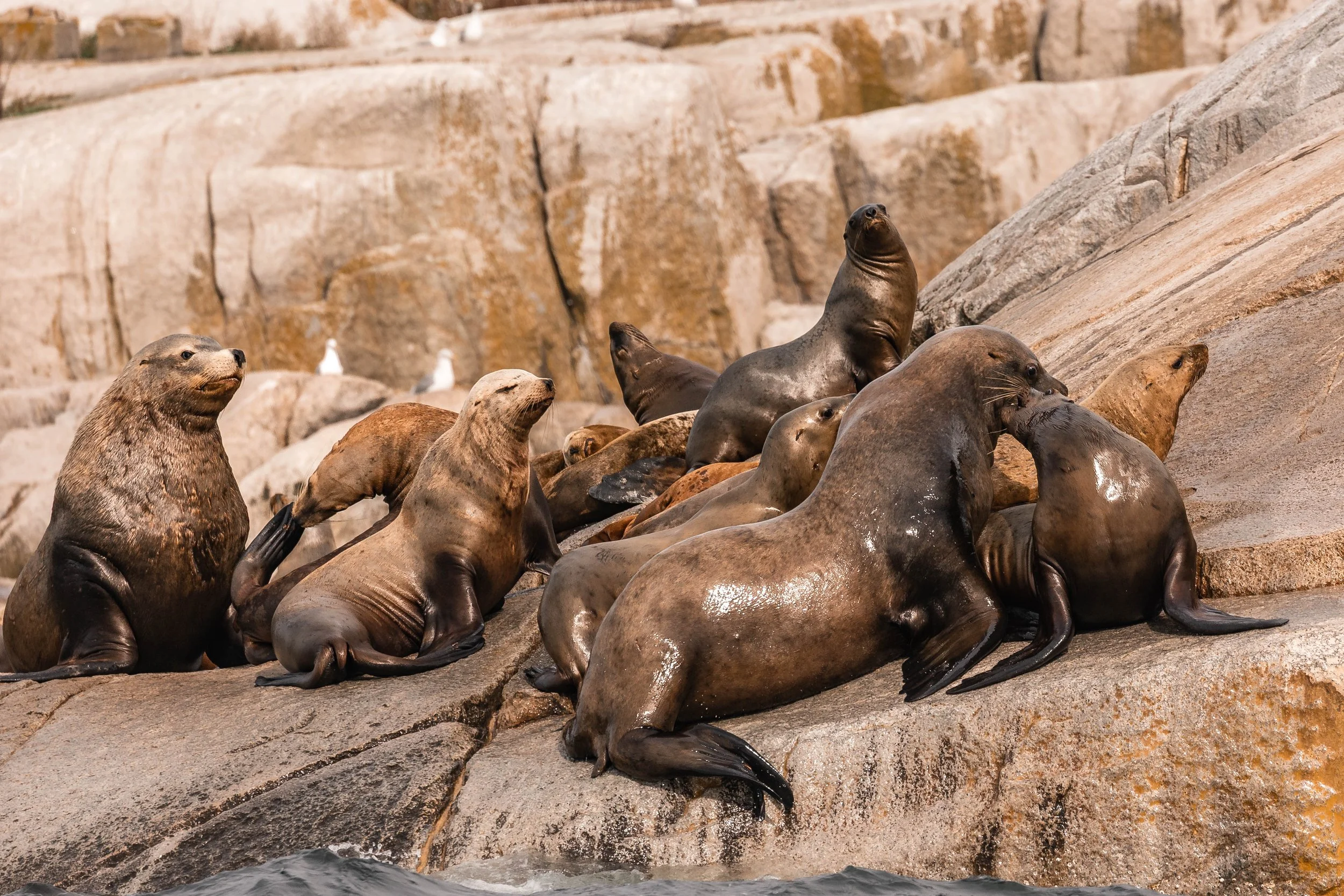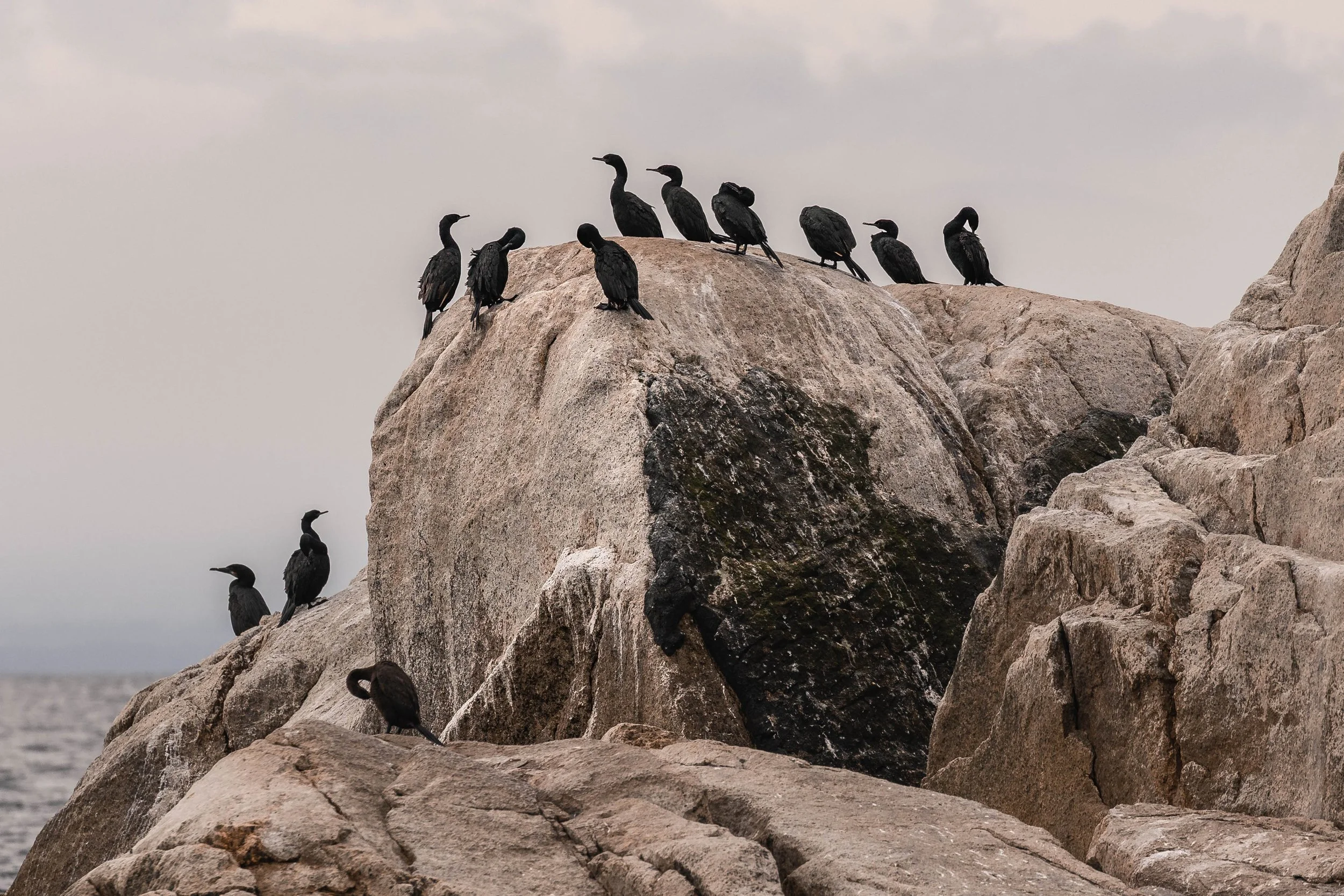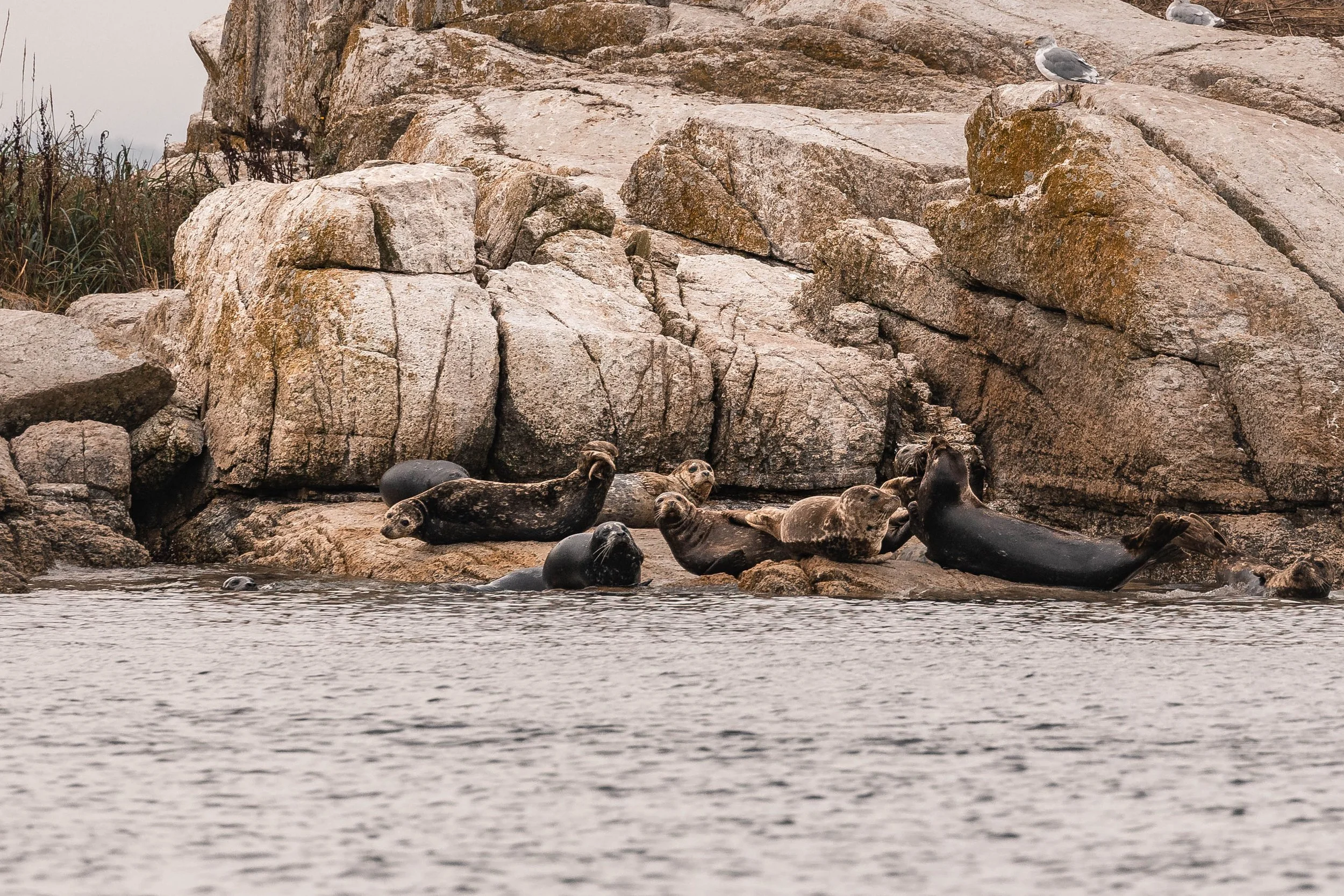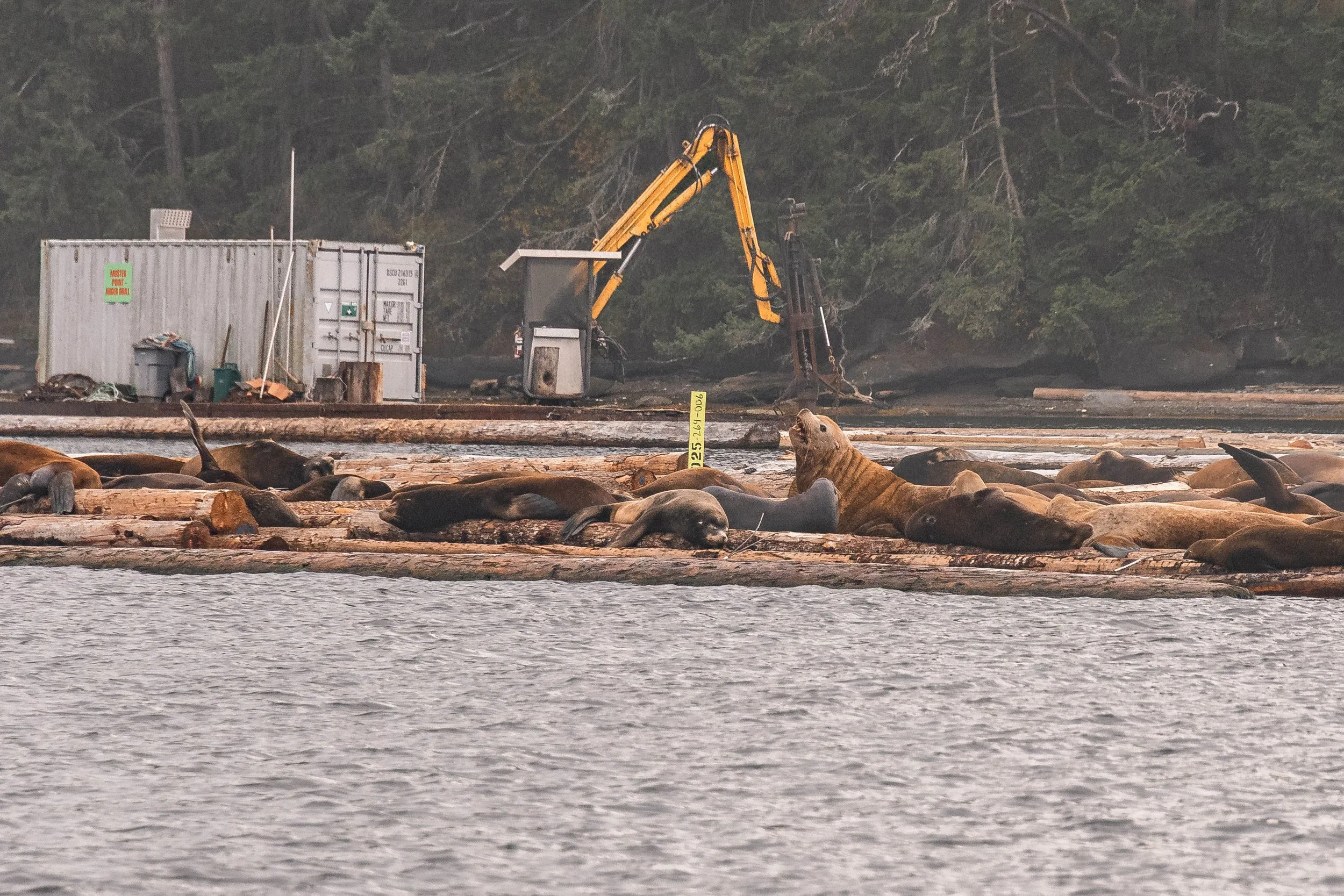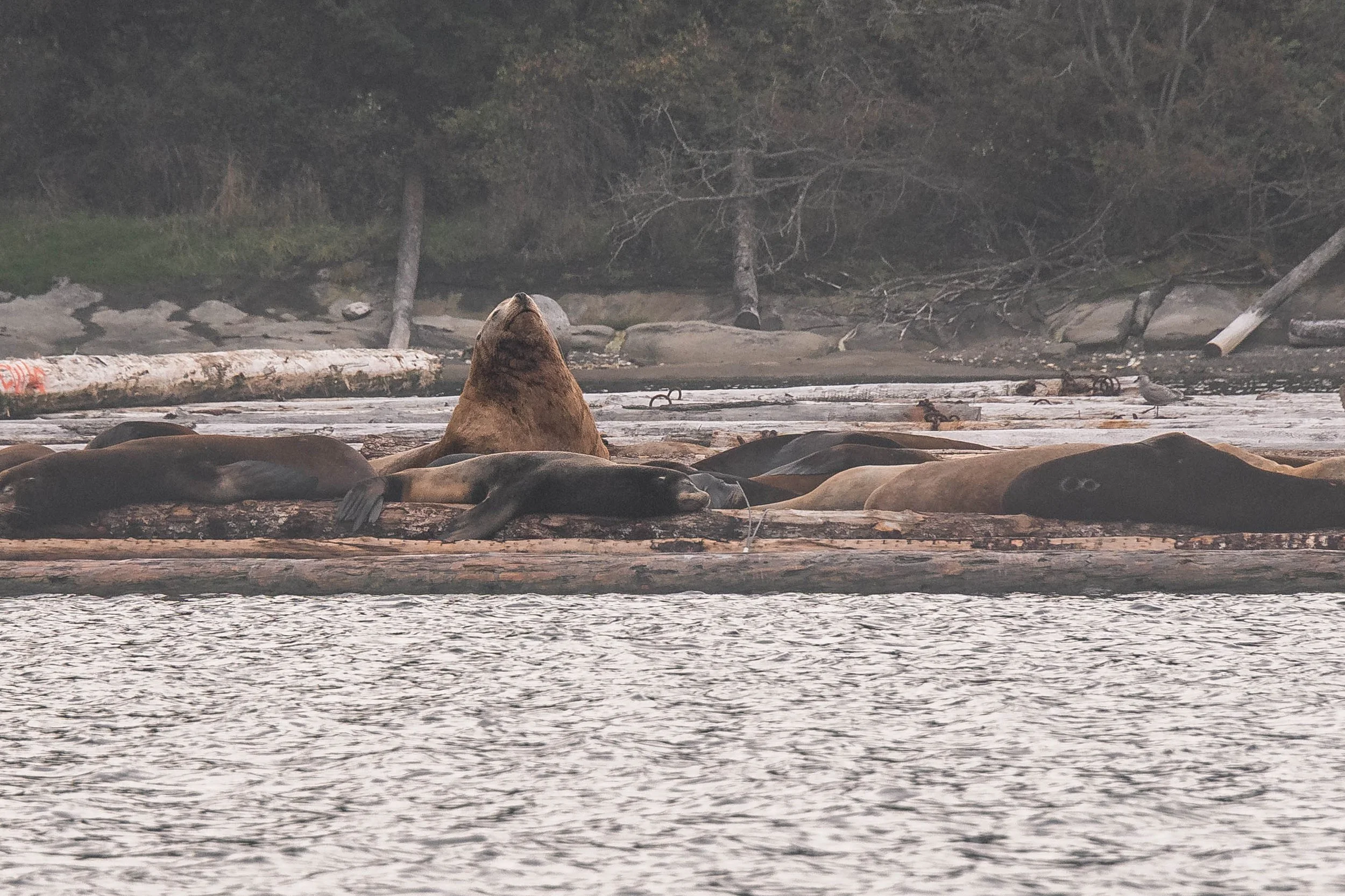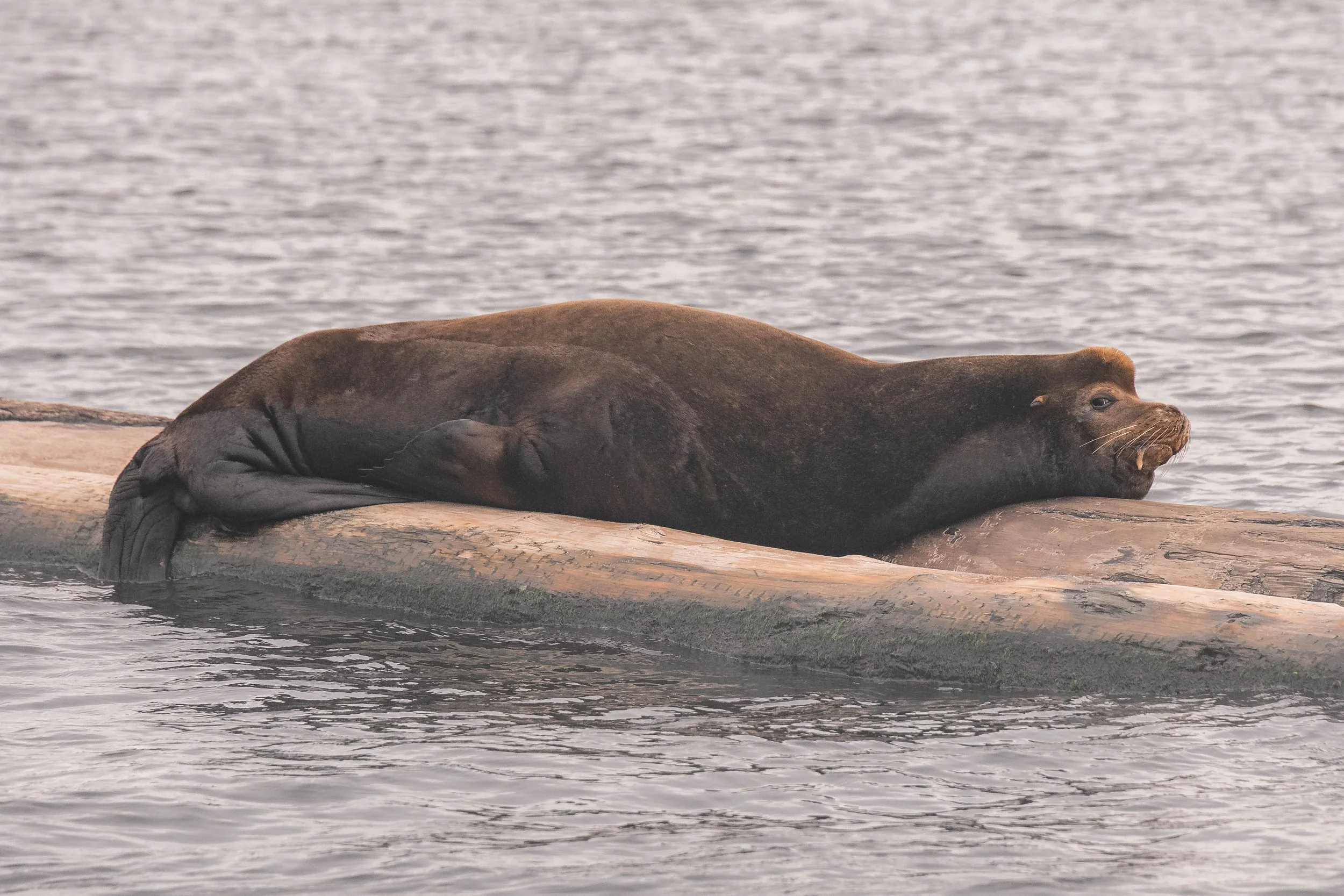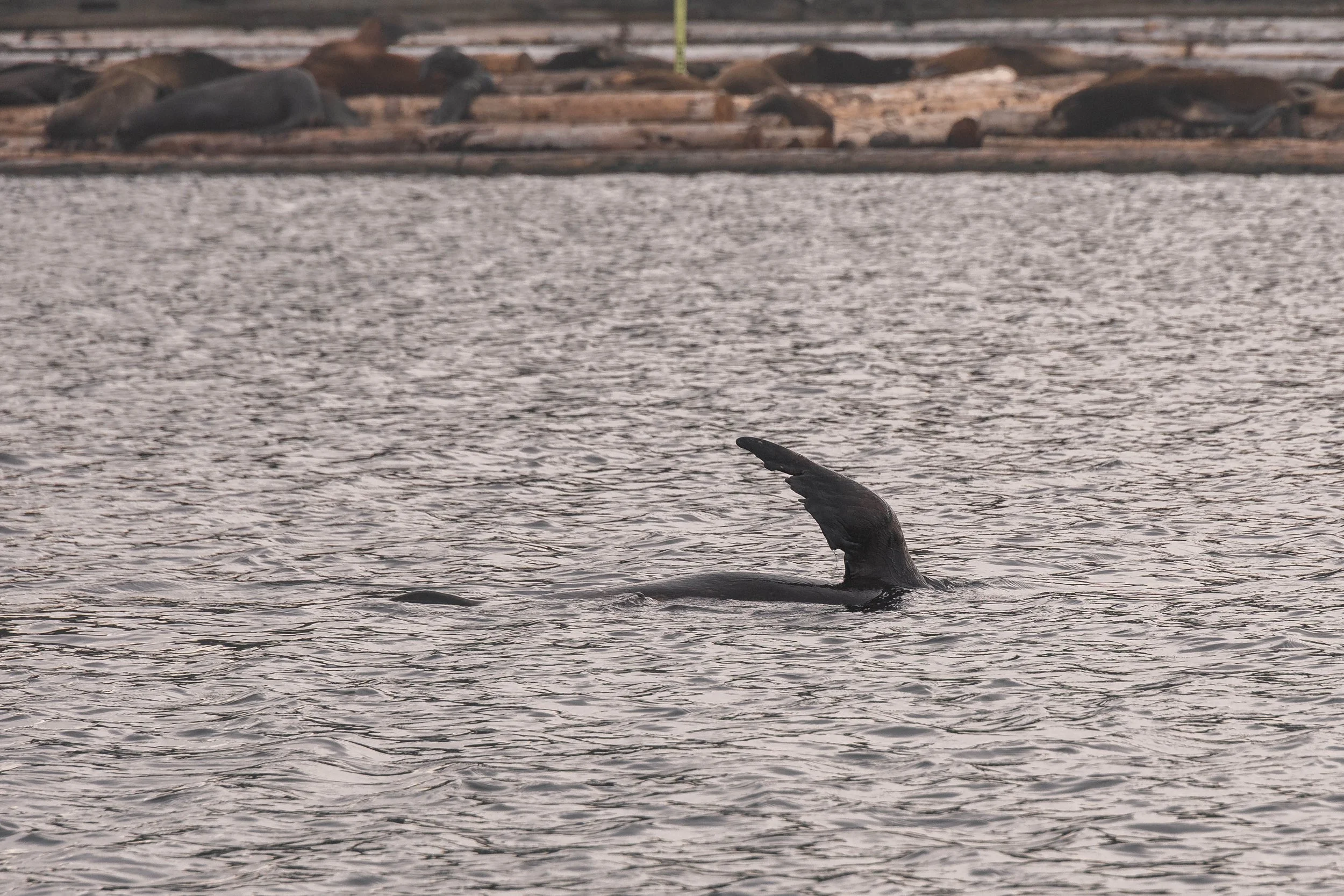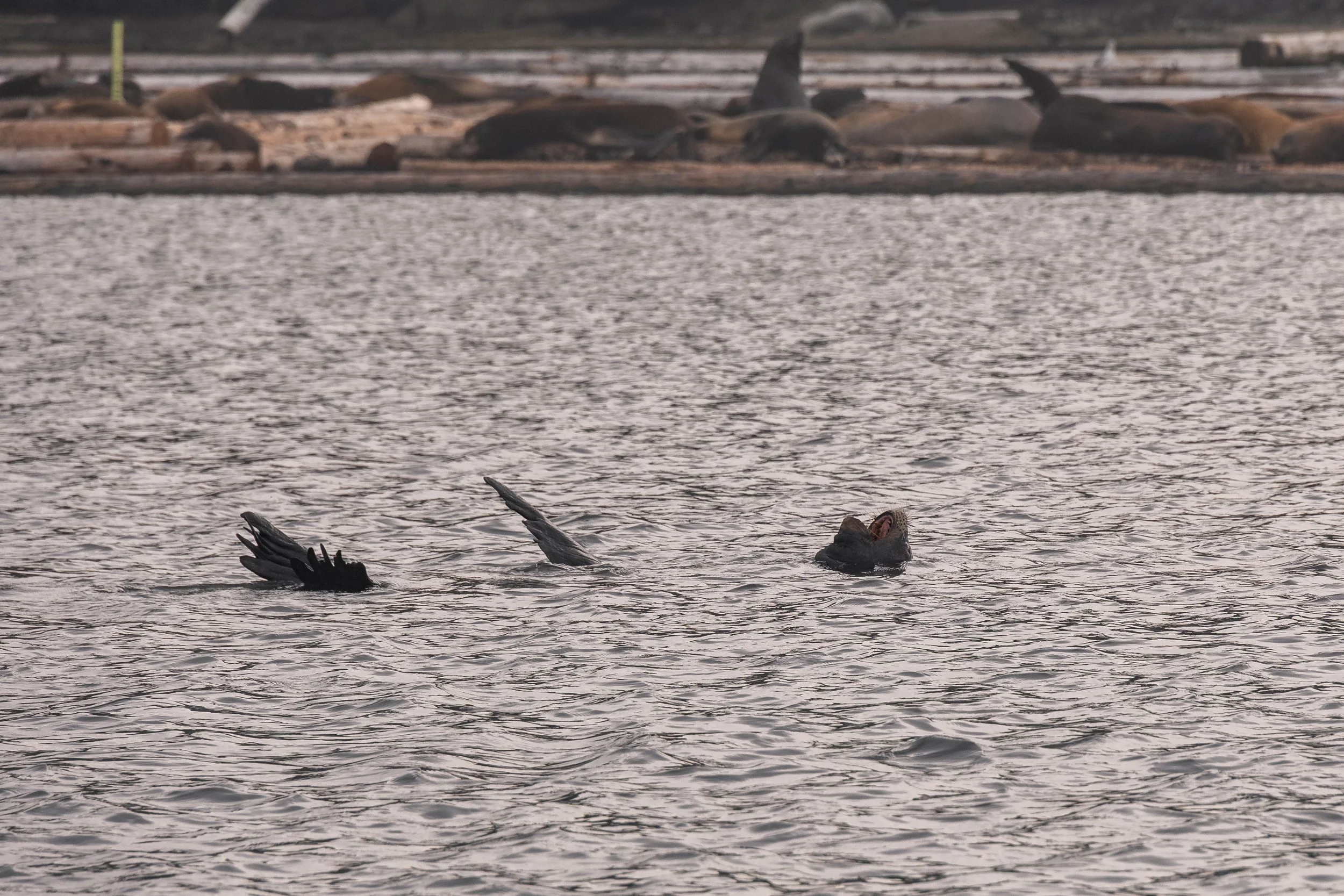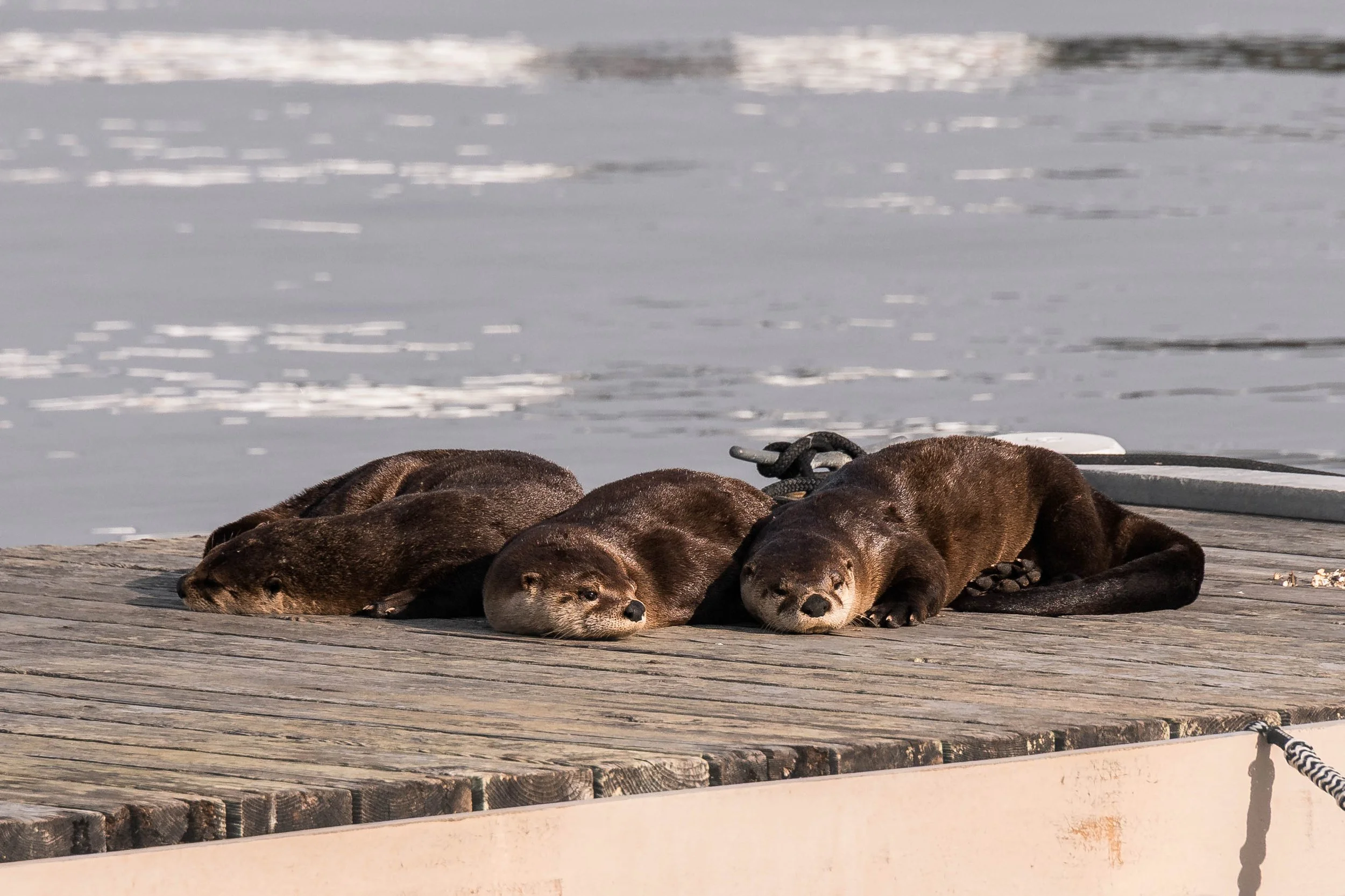September 28, 2025 - Party time with the orca, and feast time with the Humpbacks
The skies were dark, and it was looking like a perfect West Coast day when we headed on out. We began by heading north, out of the harbour, aiming towards the Strait of Georgia. Our first stop of the day was merely 30 minutes after departure, though, as we saw a pair of blows rising into the air near Snake Island! These two were slowly travelling along side-by-side. Given the drastic size difference between them, we deduced that we were looking at a mother-calf pair. The duo did not fluke while we observed them, but we were still able to confirm their identities solely from their unique dorsal fins. These two were Ghost (BCX1333) and her 2025 calf (BCX1333 calf 2025). They have been regulars in our area lately, and are likely approaching their last few months together before they say their goodbyes. Humpback calves only stay with their mother for a year before they begin adventuring around the great big sea by themselves, and that first year of life is critical for them. They need to learn which areas are most abundant in food, which areas they should avoid due to known dangers, and which are the safest routes to and from the breeding and feeding grounds.
As the leaves begin to turn, the weather cools down, and the humpbacks prepare to depart our bountiful waters, Ghost and her little calf will go on one last adventure to the Hawaii breeding grounds. We hope that next year we see both of these gentle giants back in our area, and we can celebrate the calf’s first year exploring the seas by themselves!
Once our vessels, Cascadia and Kula, had spent some time with Ghost and her child, they headed on out once more, travelling in separate directions to maximize their search area. Cascadia was the first to find more whales - another humpback pair off of Halibut Bank!
One of Cascadia’s two whales was quite cooperative as they watched, with them fluking high into the air. With these, they confirmed that they were Nalu (BCY1072). Their friend, however, was not fluking, and was simply travelling along. Unlike Ghost's and her calf's dorsal fins, this dorsal fin was quite simple and challenging to cross-match. At this time, we are still unsure who they are, but we are eager to continue sifting through our catalogues to figure out their ID!
It is possible this pair was feeding below the surface, packing on as much weight as they can. Once our humpbacks depart from our area, they rely on their fat stores to keep them energized for the duration of their migration, before they return to our area in the spring once more. Their journeys are long and taxing, and once they return to our waters, they have lost a significant portion of their body weight. Can you imagine going multiple months without eating and swimming thousands of kilometres in the process, too?
Cascadia left Nalu and their friend behind and found another humpback only a few minutes away! Kula came over and joined them, and the two naturalists on board began identifying who was present for this encounter.
This little whale was swishing their tail back and forth on the surface of the water, causing a large flock of Bonaparte’s gulls to gather all around them. Flicking and slapping their tails on the surface of the water can cause prey to ball up and become stunned, leading to an easier opportunity to feed. Once stunned, humpbacks will quickly travel along, jaws wide open as they gulp up their prey. That is exactly what this whale was doing, as they suddenly broke the surface of the water, jaws wide and baleen visible, before quickly snapping their jaws shut, locking the prey away in their large mouths. Thanks to the tail flicking, we were able to get an ID shot of this whale, and confirmed that it was KEX0086.
After an incredibly exciting time with KEX0086, Cascadia continued onward towards the mainland of BC. Kula stayed with KEX0086 for a bit longer, though, and soon a couple of other humpbacks had gathered with them and were also enjoying the spoils! One of the humpbacks that joined was identified as Helen (KEX0077), a three-year-old humpback with another unique dorsal fin. Their divoted dorsal fin is reminiscent of a mountain range, which is how they got their nickname! There was at least one other humpback present as well, but they were quite elusive, and we have not confirmed their ID at this time.
KEX0086 and Helen are both 2022 calves, born to Kappa (BCX0158) and Mammoth/Ocean (BCX1710), respectively. Feeding encounters like this offer us a unique glimpse into the world of humpback social dynamics, a topic that remains largely mysterious to us. Not long ago, we believed humpbacks were a solitary species, with most sightings of them being of a single individual travelling alone. In recent years, this has changed dramatically. Lately, we have seen frequent pairings amongst young whales like these two. While we may never know the full details of how humpbacks view eachother, we are always eager to learn and experience beautiful moments like this encounter!
After having a wonderful time with our humpbacks, we departed and continued travelling along. We had caught word of a different kind of whale sighting off the Sunshine Coast, so we were eager to head over and take a peek. Cascadia approached first, scanning the shoreline. Soon they saw one large dorsal fin and a handful of small ones beside him. The onboard Naturalist quickly grabbed a few photos of them and confirmed these four were the T090s:
T090 Eagle ♀ (1980)
T090B Piglet ♂ (2006)
T090C Tigger ♀ (2010)
T090D Kanga ♀ (2017)
The T090s seemed to be travelling along, with no particular goal in mind. Travel makes up a large portion of an orca’s day, with pods easily travelling over 100km in a single day! Transient orca have a vast home range, from Alaska all the way down to California, and unlike a lot of other whale species, they do not migrate. They travel wherever food takes them that day! The T090s tend to stay within the inner waters of the Strait of Georgia; however, they have had encounters farther north in Alaska, an incredible 1300 km north of Nanaimo!
While the T090s were exciting to find, they didn’t quite match the description we had received from the earlier sighting. We continued a bit further along when we began seeing numerous dorsal fins of all sizes popping above the surface. It appeared to be a T-party, or a gathering of multiple Transient (Bigg’s) orca matrilines travelling together! The Naturalists began snapping more photos of these dorsal fins, and confirmed members of three different matrilines were present: the T100s, T101s, and T124Ds:
T100 Hutchins ♀ (~1979)
T100C Laurel ♂ (2002)
T100F Estrella (2004)
T101 Reef ♀ (1969)
T101A Rush ♂ (1993)
T101B Lagoon ♂ (1997)
T124D Field ♀ (1996)
T124D1 Salish II (2014)
T124D3 Lupine ♀ (2022)
T124D4 Dune ♂ (2024)
Similar to the T090s, this T-party was mostly busy just travelling. The youngest member of the party, T124D4 Dune, was frequently spotted popping out of the water at speed as he tried to keep up with the others. T-parties are vital gatherings for both young and mature orca - the young get to play with new friends, potentially learn to hunt larger prey, and start interacting and making connections with whales outside their immediate family. For the mature whales, it leads to a perfect opportunity to breed and continue their lineages - and for the matriarchs, it leads to a perfect opportunity to socialize with other matriarchs, and occasionally gives them some time to relax without the young pod members relying on them 100% of the time!
While we had an abundant amount of whale sightings during our trip, those weren’t our only stops along the way! We also headed over to the White Islets, a group of rocky islands that is home to numerous coastal species. The Steller Sea Lions could be seen (and heard) fighting and posturing on each other, lumbering along to the best spots to rest. Around the corner in a sheltered bay, the much quieter Harbour Seals were observed stretching, yawning, and dozing near the edge of the water. There was also an abundance of Cormorants walking the shores, peeking down into the depths below. We also stopped by the Harmac pulpmill, where our California Sea Lions prefer to haul out. The log booms here provide a perfect place for them to rest before hopping into the waters to fish through Dodd Narrows, a tiny waterway mere minutes from the haulout, and a perfect place for them to catch a bite to eat.
Please enjoy these photos taken by Marine Naturalists Hayleigh Hilbert and Desarae Poier.
Ghost and her calf behind her. Photo by Desarae Poier.
Nalu and her unidentified friend. Photo by Hayleigh Hilbert.
Nalu’s shy friend. Photo by Hayleigh Hilbert.
KEX0086 flicking their tail at the surface. Photo by Hayleigh Hilbert.
A perfect splash arch after tail slapping, with many Bonaparte’s gulls flying around too. Photo by Hayleigh Hilbert.
KEX0086’s mouth open at the surface, baleen visible. Photo by Hayleigh Hilbert.
My, what a big mouth you have! Photo by Hayleigh Hilbert.
KEX0086 diving. Photo by Desarae Poier.
Making a splash! Photo by Desarae Poier.
Another quick flick at the surface from KEX0086. Photo by Desarae Poier.
KEX0086 diving. Photo by Desarae Poier.
Exhaling. Photo by Desarae Poier.
Preparing to dive. Photo by Desarae Poier.
The gulls had to be careful, or they’d get smacked themselves! Photo by Desarae Poier.
Pushing through the surf. Photo by Desarae Poier.
Pectoral fins can also be used to feed. Photo by Desarae Poier.
Snapping their jaws shut. Photo by Desarae Poier.
The tip of Helen’s dorsal fin with KEX0086 beside them. Photo by Desarae Poier.
KEX0086 diving at an interesting angle. Photo by Desarae Poier.
Helen diving (top fluke) with Bonapartes gulls all around them. Photo by Desarae Poier.
KEX0086’s dorsal fin. Photo by Desarae Poier.
T090 Eagle. Photo by Hayleigh Hilbert.
T090B Piglet cruising the shoreline. Photo by Hayleigh Hilbert.
T100C Laurel traveling through the waves. Photo by Hayleigh Hilbert.
T124D Field. Photo by Desarae Poier.
T101B Lagoon. Photo by Desarae Poier.
T101A Rush. Photo by Desarae Poier.
T100C Laurel. Photo by Desarae Poier.
T100C Laurel and T124D1 Salish II. Photo by Desarae Poier.
T101 Reef in the lead, with others behind her. Photo by Desarae Poier.
T101 Reef, with little T124D4 Dune surfacing behind them (eyepatch/face) and T100F Estrella beside them. Photo by Desarae Poier.
T100 Hutchins. Photo by Desarae Poier.
T124D4 Dune’s face above the water! Photo by Desarae Poier.
T124D1 Salish II following close behind T100C Laurel. Photo by Desarae Poier.
The White Islets - Population: Pinniped! Photo by Desarae Poier.
Discourse at the haulouts is quite common. Photo by Desarae Poier.
So is crowdsurfing to get to the best spots! Photo by Desarae Poier.
Cormorants overlooking the seas! Photo by Desarae Poier.
Harbour Seals relaxing at the water’s edge. Photo by Desarae Poier.
A Great Blue Heron balancing on the logs. Photo by Hayleigh Hilbert.
Snoozing and grumbling sea lions at the log booms by Harmac. Photo by Hayleigh Hilbert.
A large lumbering Steller Sea Lion amongst the significantly smaller California Sea Lions. Photo by Hayleigh Hilbert.
A drooling California Sea Lion. Photo by Hayleigh Hilbert.
Sometimes travelling sea lions can be mistaken for orca - can you see why? Photo by Hayleigh Hilbert.
A biiiiiiig stretch from a California Sea Lion, with both rear flippers, one side flipper, and their head visible. Photo by Hayleigh Hilbert.
River Otters snoozing on the docks. Photo by Hayleigh Hilbert.

